After I first began lifting within the mid-2000s, one close to-ubiquitous piece of recommendation was that lifters ought to goal to devour about 1 gram of protein per pound of physique weight (or 2.2g/kg). I don’t recall ever seeing an in-depth scientific dialogue concerning the subject, however I additionally wasn’t notably tapped into “evidence-based” lifting circles on the time, so do with that what you’ll.
Nonetheless, I do vividly bear in mind when a meta-analysis on the topic of optimum protein consumption for lifters was printed in 2018 by Morton and colleagues1. After this level, the dominant pondering on protein consumption shifted drastically, with most individuals believing that the advantages of consuming extra protein maxed out at round 0.7-0.8g/lb, and the traditional “1g/lb” advice was labeled a “fantasy” or “broscience.”
This 2018 meta-analysis included 49 research with a complete of 1863 individuals. To be included, a examine wanted to incorporate a minimum of 6 weeks of resistance coaching, and it couldn’t deliberately prohibit vitality consumption (i.e. weight reduction research had been excluded). The principle takeaway of the meta-analysis was fairly easy and easy: “protein intakes at quantities better than ~1.6 g/kg/day don’t additional contribute [resistance training]-induced positive factors in [fat free mass].”
To reach at this conclusion, the researchers plotted protein intakes (x-value) versus adjustments in fat-free mass (y-value), and carried out a biphasic linear regression to establish a “breakpoint”: the purpose previous which additional will increase in protein consumption fail to yield additional will increase in fat-free mass (i.e., the purpose previous which the slope of a linear trendline equals 0). For this evaluation, a complete of 42 examine arms with a complete of 723 topics had been included. You possibly can see the ensuing determine under.
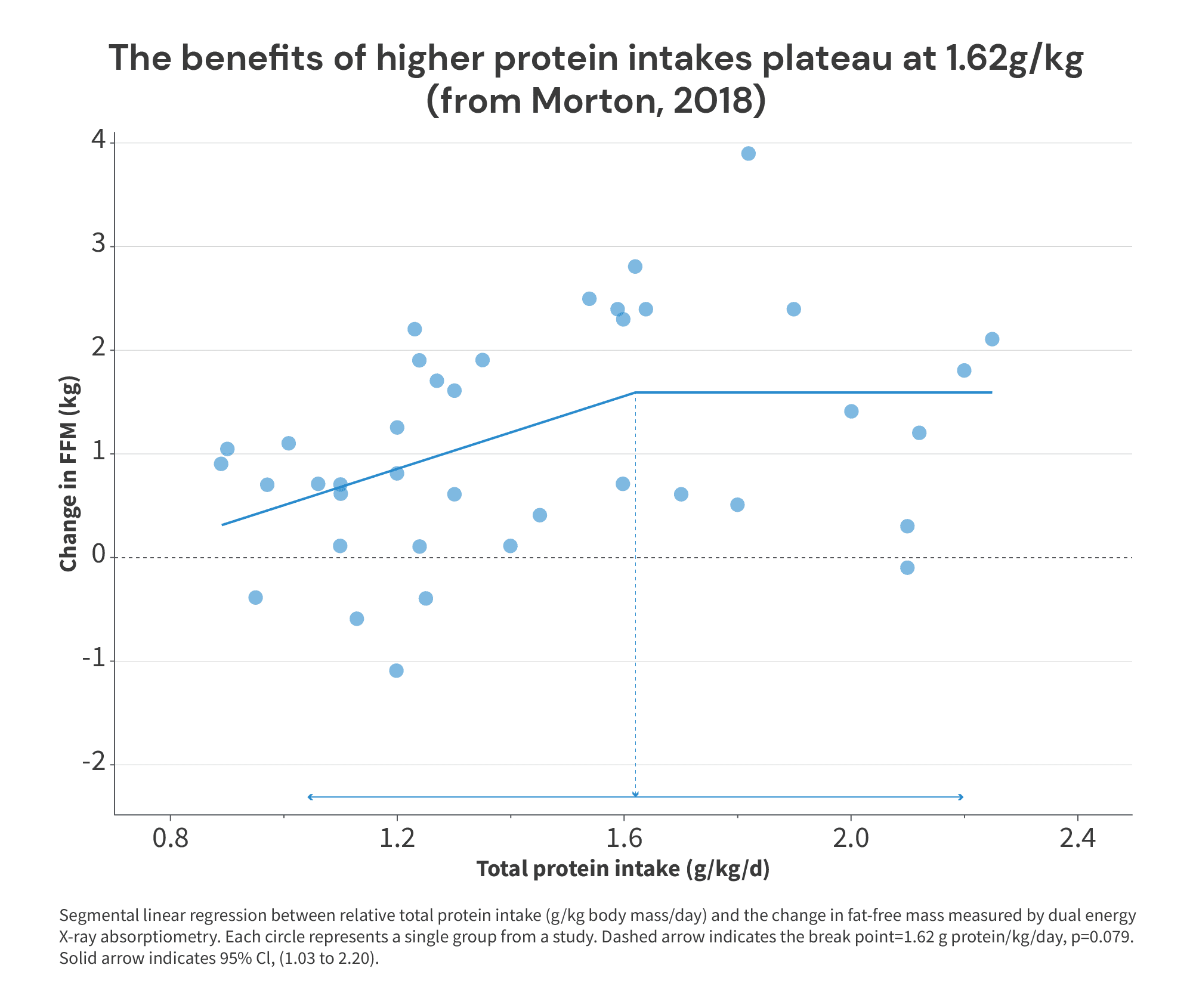
As you may see, the breakpoint is at 1.62g/kg (about 0.74g/lb), suggesting that will increase in protein consumption past 1.62g/kg fail to yield additional will increase in fat-free mass. Easy sufficient, proper?
Properly … this determine itself ought to have clued most individuals into the truth that this wasn’t essentially an open-and-shut case. For starters, the breakpoint itself wasn’t even statistically important (p = 0.079). We might certainly quibble about how a lot weight we must always place on “significance” as a (pretty arbitrary) statistical threshold typically. However a meta-analysis is a spot the place you’d actually anticipate to see statistically important outcomes if what you’re analyzing is a “actual” impact, just because a meta-analysis ought to provide you with such a big improve in statistical energy in comparison with a standalone trial. So, we by no means ought to have had a ton of religion in 1.62g/kg as a very correct or exact breakpoint.
Relatedly, the arrogance interval for the (non-significant) breakpoint spanned a variety from 1.03-2.20 g/kg. Notably, the protein intakes meta-analyzed spanned a variety that was solely barely wider than the arrogance interval of the breakpoint: about 0.9-2.25 g/kg. In different phrases, the vary of believable values for the (non-significant) breakpoint wasn’t a decent, particular vary of values throughout the dataset – it spanned virtually the complete vary of protein intakes studied.
In different phrases, these outcomes have been broadly interpreted as saying “now we have quite a lot of confidence that you just gained’t derive hypertrophic advantages from consuming greater than 1.62g of protein per kg of physique mass.” Nonetheless, a studying that higher displays the precise statistical outcomes of the breakpoint evaluation could be one thing a lot nearer to, “we’re not notably assured that there is a degree previous which rising protein consumption fails to yield additional will increase in fat-free mass. And, if that time exists, we’re additionally not notably assured about the place it would lie.”
Moreover, the Morton meta-analysis itself additionally presents information suggesting that the breakpoint (if one exists) might be larger than 1.62g/kg. However, these information can solely be present in some supplementary figures that haven’t obtained almost as a lot consideration because the breakpoint evaluation pictured above (however which aren’t any much less legitimate or informative), so I assume most individuals have utterly missed them. Specifically, we have to flip our consideration to Supplementary Figures 3A-D:


I notice there’s loads happening in these figures, however they’re fairly easy. Figures A-C plot baseline protein consumption on the x-axis, and the distinction in FFM positive factors between teams receiving versus not receiving protein supplementation on the y-axis.
So, think about you have got a pool of topics consuming 1.2g/kg of protein at baseline. Half of the themes obtain a protein complement to extend their protein consumption to 1.5g/kg, whereas the opposite half of the themes function a management group and proceed consuming 1.2g/kg. On the finish of the examine, the themes within the supplementation group achieve 1.4kg of fat-free mass, and the themes within the management group achieve 1.0kg of fat-free mass. With these outcomes, you’d plot the purpose (1.2,0.4). That time would inform you that baseline protein consumption was 1.2g/kg, and including supplemental protein on prime of the baseline consumption of 1.2g/kg led to an extra 0.4kg improve in FFM, in comparison with not rising protein consumption.
Now, if protein intakes above 1.62g/kg didn’t result in additional will increase in fat-free mass, what ought to we anticipate to see in these figures?
We should always anticipate to see that low x-values (low baseline protein intakes) correspond to larger y-values (bigger advantages from rising protein consumption), and that x-values above ~1.62g/kg correspond to y-values of ~0 (which means that rising protein consumption above a baseline consumption of 1.62g/kg fails to result in additional positive factors in FFM). In different phrases, we must always see a chart with a development that appears one thing like this:
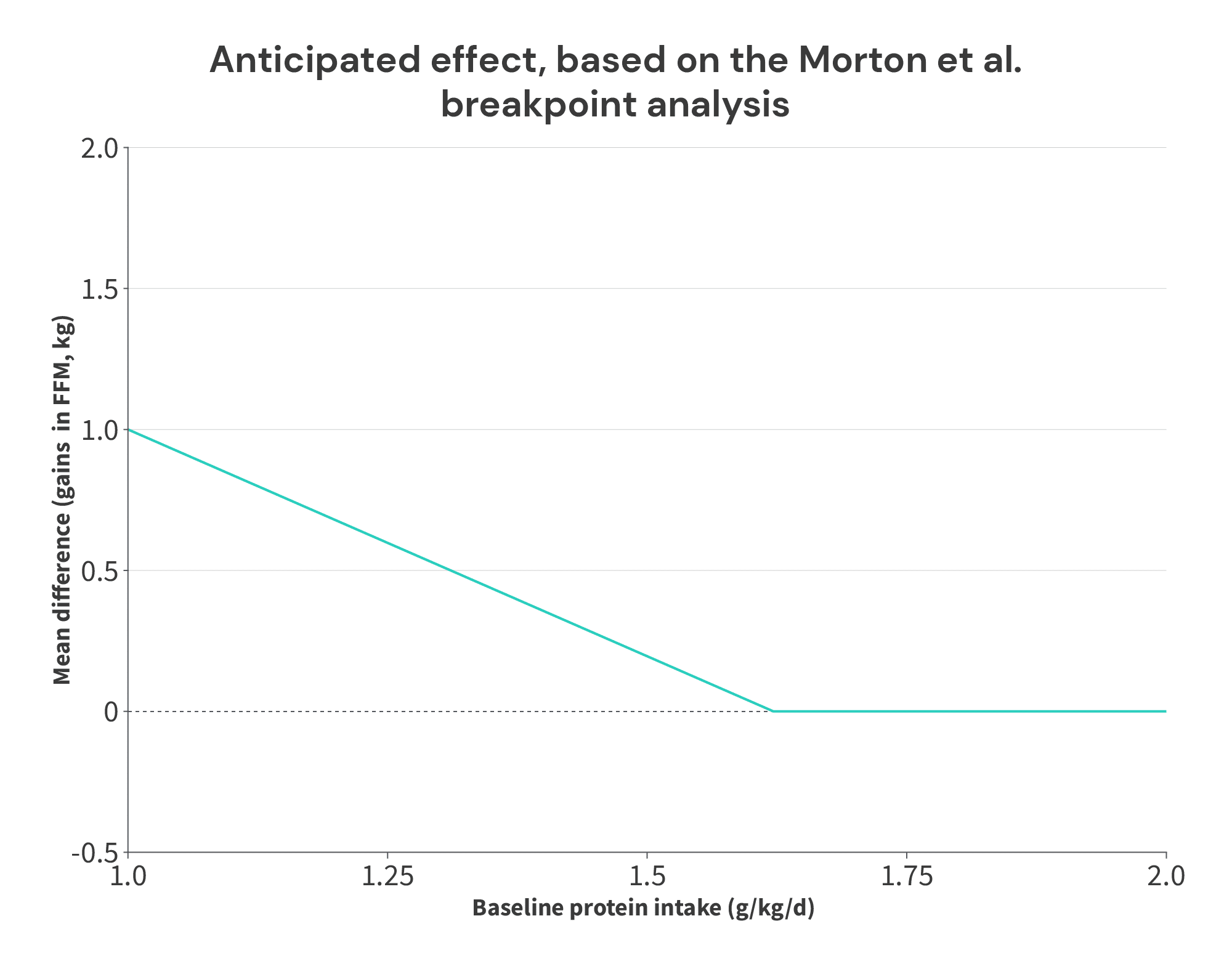

Principally, if the optimistic affect of protein on FFM accretion plateaus at an consumption of 1.62g/kg, you must anticipate that will increase in protein consumption past that time shouldn’t result in bigger positive factors in FFM. So, if a gaggle is already consuming 1.62g/kg, they usually additional improve their protein consumption, this extra improve shouldn’t result in bigger will increase in FFM (in comparison with one other group that continues to devour 1.62g/kg).
Nonetheless, that’s not what we see in Supplementary Determine 3. As an alternative, we have a tendency to look at that larger baseline protein intakes are related to barely bigger advantages from extra protein consumption. Now, I wouldn’t put an excessive amount of inventory within the total optimistic associations seen in graphs A-C – when decomposed by age (graphs B and C), the associations are weak and nonsignificant (p > 0.4). However, these relationships are distinctly not the general unfavourable relationships one ought to anticipate if there was really a breakpoint at 1.62g/kg. And, notably, in all 5 situations the place topics had been consuming close to or above 1.6g/kg of protein at baseline, additional will increase in protein consumption uniformly led to additional will increase in FFM:
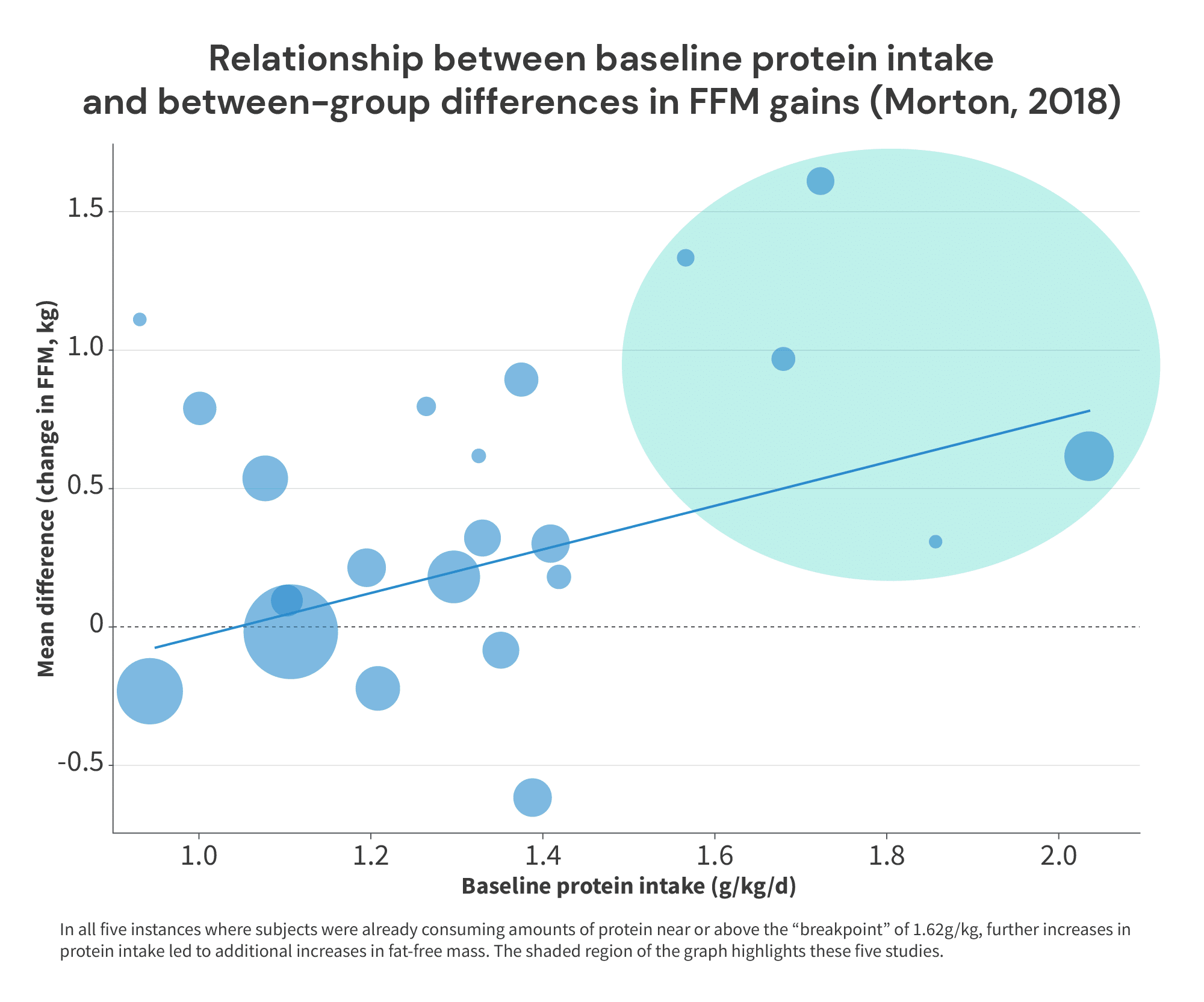

So, this leaves us with a little bit of a thriller: the info introduced on this determine appears to battle with the breakpoint evaluation introduced above. How can each analyses be correct?
Luckily, there’s a straightforward rationalization: larger baseline protein intakes had been barely negatively related to positive factors in fat-free mass (particularly in youthful topics), as you may see in graph D above.
I assume what we’re coping with right here is an instance of Simpson’s Paradox. In essence, Simpson’s Paradox is the title given to the phenomenon that happens when developments that come up when analyzing information on one degree battle with developments that come up when analyzing the info on one other degree.
Right here’s a easy illustration: let’s assume now we have this set of 8 theoretical research, investigating the affect of coaching quantity on muscle progress.


In all instances, 2 extra units yield 4 extra items of hypertrophy. Appears easy sufficient, proper? Extra coaching quantity yields extra progress. We will categorical this graphically under, very similar to Supplementary Determine 3 A-C from the Morton meta-analysis.
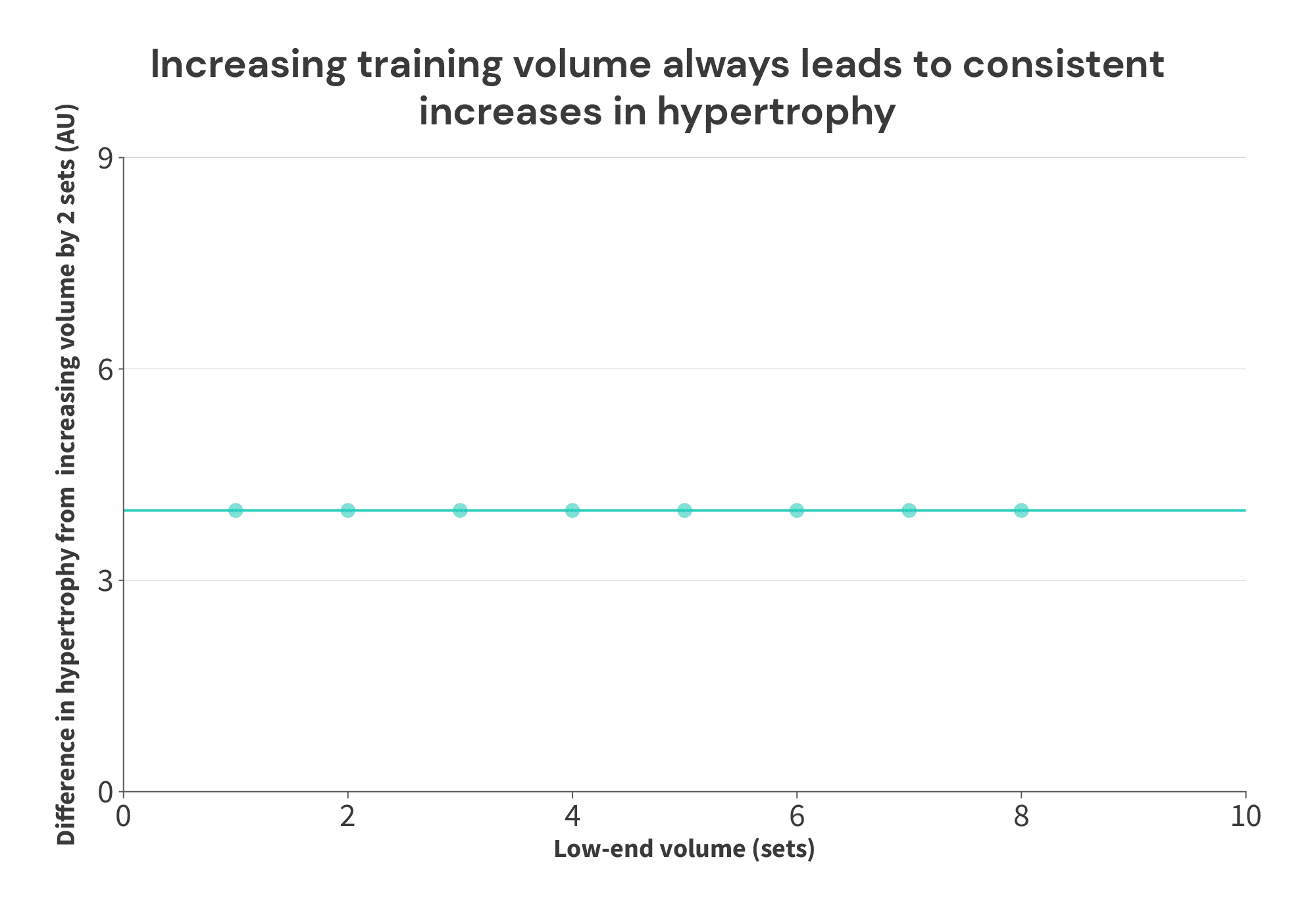

Nonetheless, issues look fairly a bit totally different if we simply make a graph of the quantity carried out in every group, versus the hypertrophy achieved in every group (extra much like the breakpoint evaluation within the Morton meta-regression):
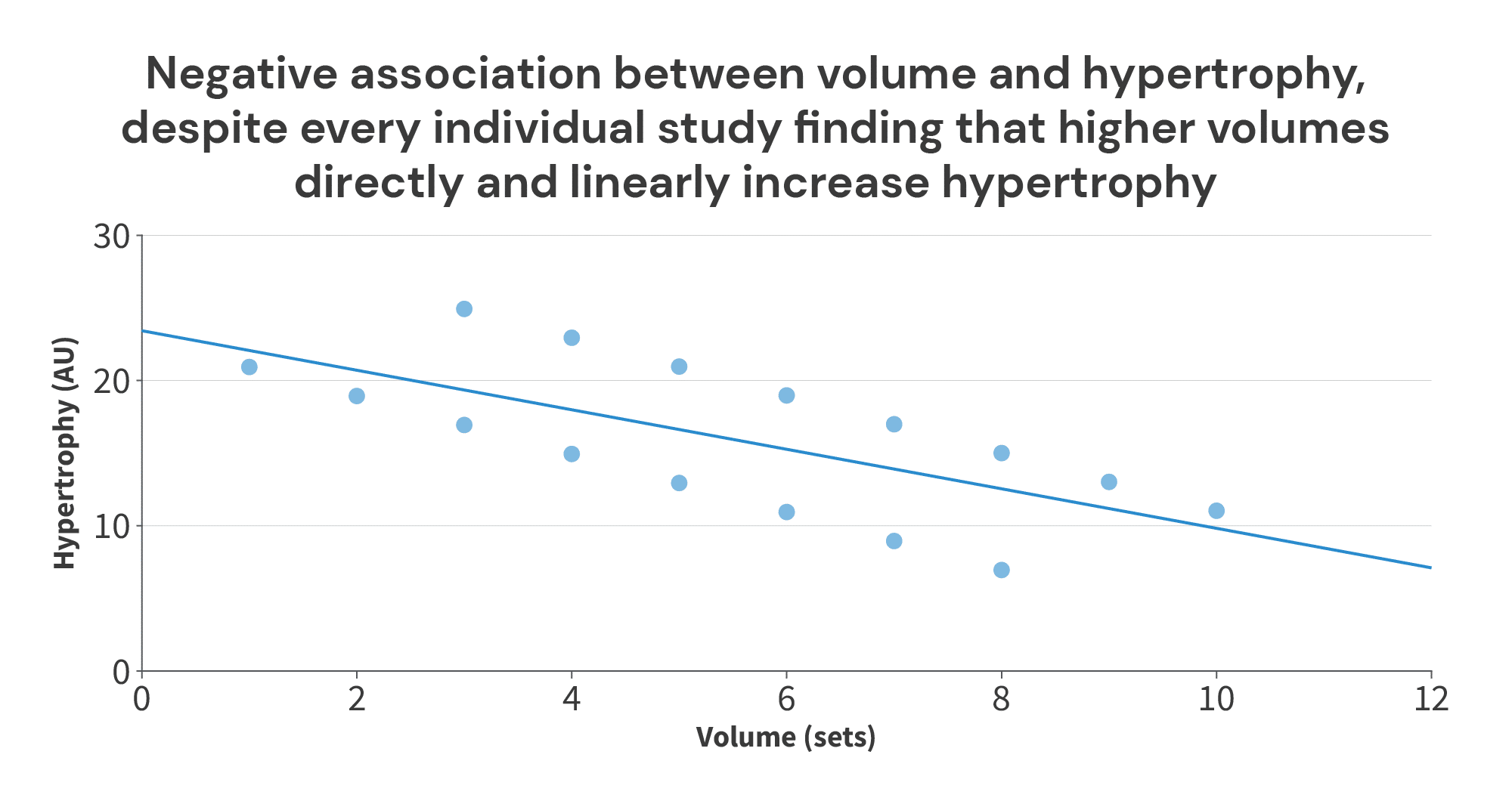

So, on this case, in case you’re presently doing 8 units, what coaching adjustment do you assume is almost definitely to result in extra muscle progress? Do you assume you’d be extra seemingly to enhance your outcomes by rising your coaching quantity to 10 units per week? Or do you assume you’d be extra seemingly to enhance your outcomes by lowering your coaching quantity to three units per week?
I believe I (and most different folks) would suggest rising coaching quantity to 10 units per week.
However, why may a relationship like this (totally different outcomes once you evaluate outcomes inside research versus evaluating outcomes between research) come up within the first place?
Most regularly, it’s as a result of topic traits differ between teams or research, and people variations in topic traits result in variations in common outcomes, even when the affect of the intervention doesn’t change. For instance, on this quantity/hypertrophy illustration, perhaps the research had been ordered by coaching standing (with untrained topics in Examine 1, and elite bodybuilders in Examine 8). The examine that assigned the bottom coaching volumes (Examine 1 – 1 vs. 3 units) was additionally the examine the place you’d anticipate to see the best total progress, no matter coaching quantity, and the examine that assigned the very best coaching volumes (Examine 8 – 8 vs. 10 units) was additionally the examine the place you’d anticipate to see the least total progress, no matter coaching quantity. So, the general unfavourable relationship between quantity and hypertrophy within the determine above is pushed by variations in topic traits, not by variations in coaching quantity. No matter topic traits, the intervention itself yielded the identical impact (rising coaching quantity elevated muscle progress).
Now, actual information isn’t as clear because the illustrative information above, however I do assume any such dynamic is the principle factor contributing to the looks of a breakpoint within the Morton meta-regression. A lot of the research (39 out of 49) included in any of the analyses within the paper used untrained individuals, and the research that did use skilled individuals tended to have fairly excessive protein intakes, even within the teams that didn’t improve their protein consumption.
As an example, the “easy” meta-analysis (simply whether or not protein supplementation results in additional will increase in fat-free mass, disregarding any dose-response relationship) included 4 research on skilled lifters: Cribb (2007), Hoffman (2007), Hoffman (2009), and Kerksick (2006).
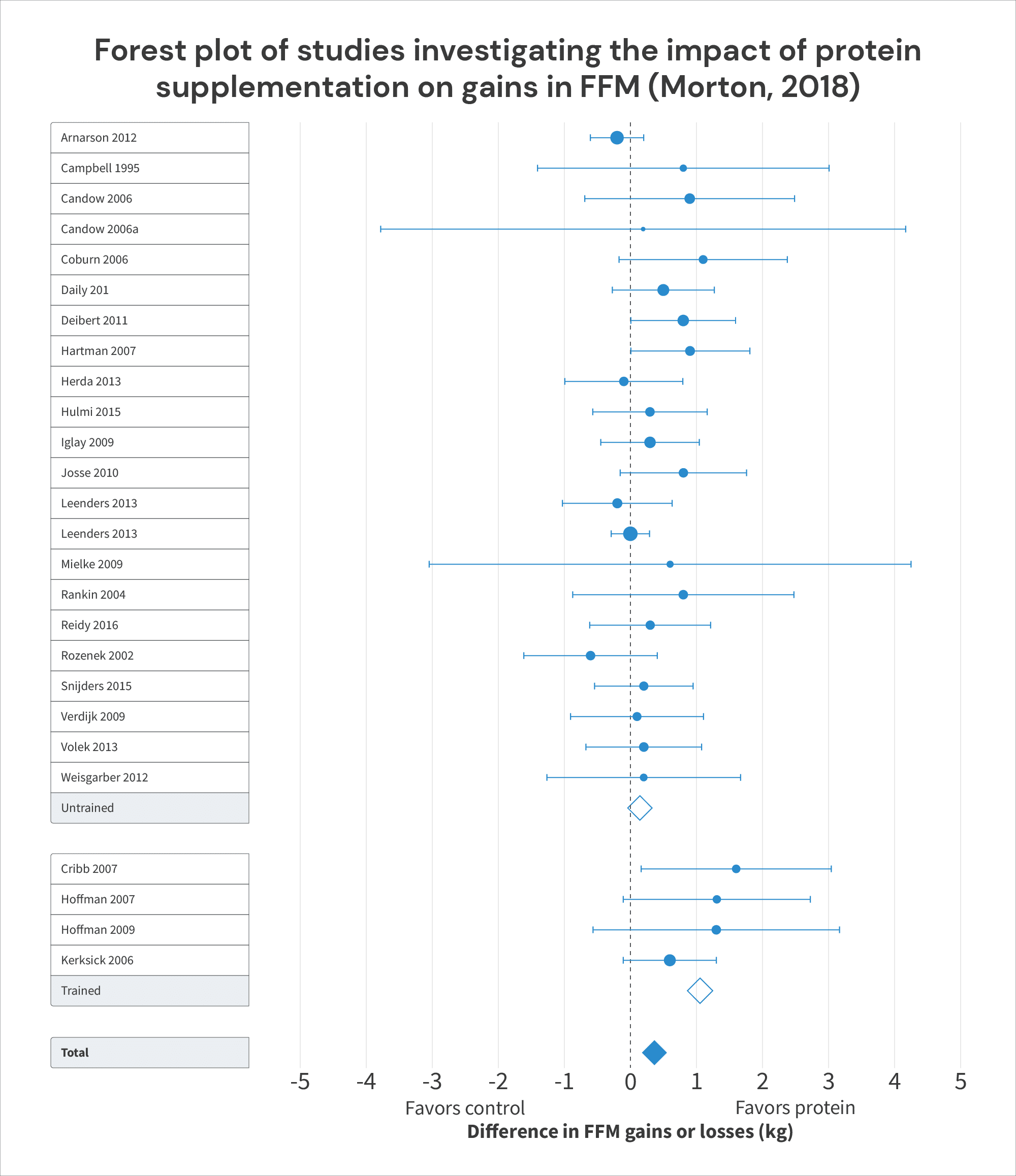

All 4 of those research discovered that rising protein intakes tended to additionally result in bigger will increase in FFM. The pooled impact of accelerating protein consumption in these research was an extra 1.05kg of FFM (95% CI = 0.61-1.50; p < 0.0001), which was significantly bigger than the (non-significant) impact noticed in untrained lifters, who solely gained an extra 0.15kg (95% CI = -0.02 -0.31kg; p = 0.08) with elevated protein consumption. This led the researchers to conclude that “Protein complement is simpler at bettering FFM in … resistance-trained people than in … untrained people.”
Nonetheless, in three of those 4 research, protein intakes within the management teams had been already close to or above the “breakpoint” of 1.62g/kg: the management teams consumed round 1.63g/kg in Cribb, 1.63g/kg in Hoffman (2009), and 1.58g/kg in Kerksick. Moreover, in all three of those research, the management teams didn’t achieve a lot fat-free mass (0.7kg in Cribb, 0.4kg in Hoffman, and 0.1kg in Kerksick), however the experimental teams did (2.3kg in Cribb, 1.65kg in Hoffman, and 1.8kg in Kerksick):
| Impression of protein supplementation on positive factors in FFM in skilled topics (from Morton, 2018) | ||||
| Examine | Management group | Experimental group | Distinction in FFM or LBM gained (kg) | |
| Cribb, 2007 | Protein consumption (g/kg) | 1.63 | 2.92 | |
| Change in FFM or LBM (kg) | 0.7 | 2.3 | 1.6 | |
| Hoffman, 2007 | Protein consumption (g/kg) | 1.24 | 2 | |
| Change in FFM or LBM (kg) | 0.1 | 1.4 | 1.3 | |
| Hoffman, 2009 | Protein consumption (g/kg) | 1.63 | 2.22 | |
| Change in FFM or LBM (kg) | 0.4 | 1.65 | 1.25 | |
| Kerksick, 2006 | Protein consumption (g/kg) | 1.58 | 2.32 | |
| Change in FFM or LBM (kg) | 0.1 | 1.8 | 1.7 | |
After we plot the outcomes from these research on skilled lifters, it doesn’t appear like 1.62g/kg is the place the helpful results of protein consumption on skilled lifters finish. Relatively, it appears like 1.62g/kg is way nearer to the purpose at which they start, as we observe pretty small positive factors in LBM or FFM at intakes round 1.6g/kg, and far bigger positive factors as intakes exceed 2g/kg:
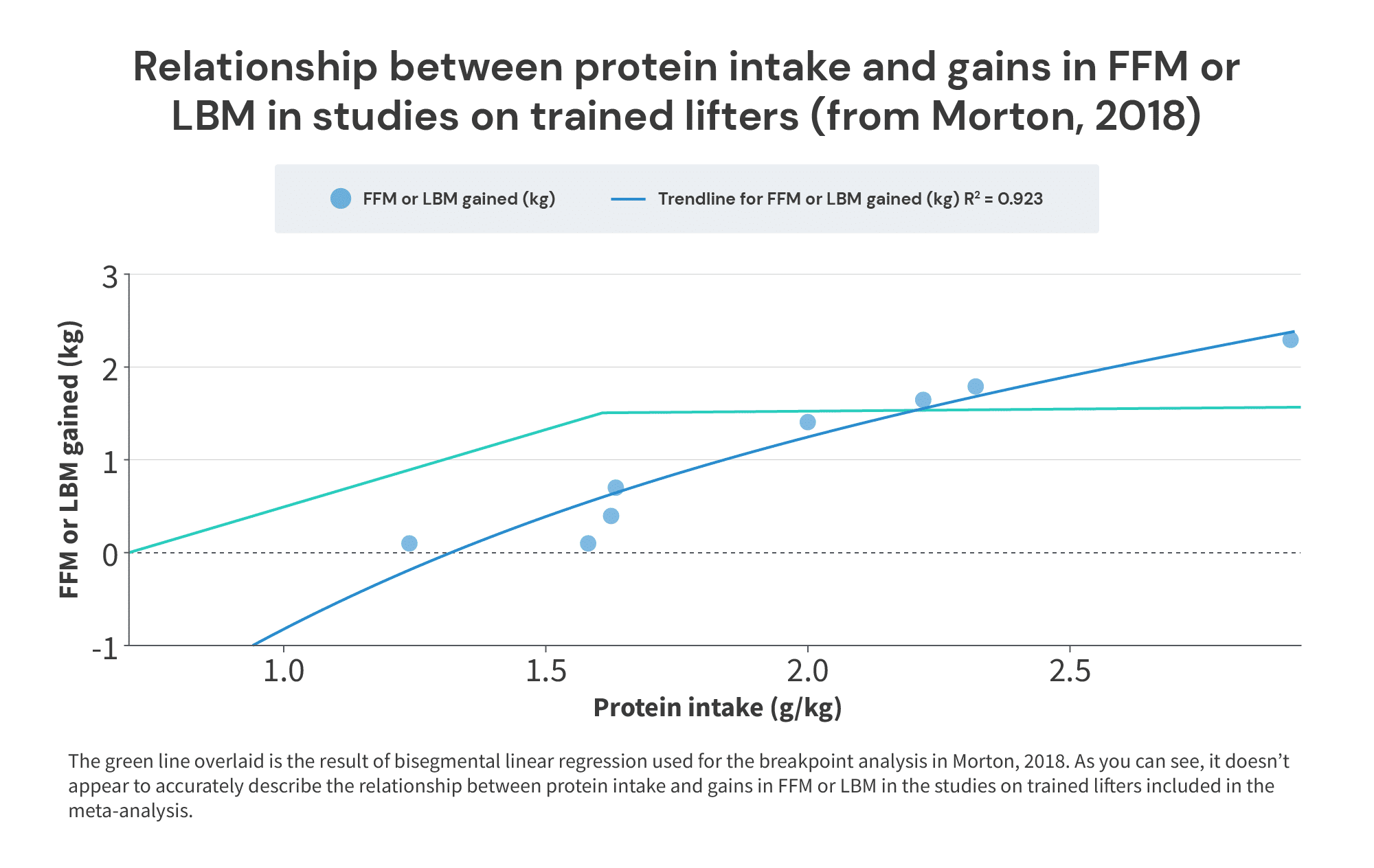

So, simply to sum up this part: the meta-analysis folks cite as robust proof that lifters don’t must devour greater than 1.62 grams of protein per kilogram of physique mass … doesn’t really present notably robust proof to help that declare. In actual fact, in all the included research the place topics began at (or above) 1.6g/kg, after which additional elevated their protein consumption, these additional will increase in protein consumption led to extra will increase in FFM or LBM. I suspect this obvious divergence within the outcomes of various analyses is because of some type of Simpson’s Paradox.
Moreover, I suspect that variations in coaching standing are the first issue explaining the divergence: research with skilled lifters could also be concurrently extra prone to:
a) observe smaller total will increase in FFM
b) take a look at larger total protein intakes (in each the experimental and management arms of the research), and
c) nonetheless observe that rising protein intakes (above 1.62g/kg) results in additional positive factors in FFM
Since 2018, a pair extra massive meta-regressions on the connection between protein consumption and positive factors in FFM/LBM have been printed.
The primary is from 2020, by Tagawa and colleagues. It had a couple of variations from the Morton meta-regressions.
- The largest distinction is that it analyzed research each with and and not using a resistance coaching element. Nonetheless, the researchers separated the lifters and non-lifters for his or her most important analyses, permitting us to nonetheless see the connection between protein consumption and positive factors in FFM in lifters particularly.
- The researchers allowed weight reduction research to be included, in contrast to the Morton meta-regression (so, in impact, the Tagawa meta-regression was concurrently analyzing the affect of protein consumption on gaining fat-free mass when gaining or sustaining weight, and the affect of protein consumption on preserving fat-free mass when losing a few pounds).
- The researchers opted for a barely totally different analytical method. As an alternative of looking for a particular breakpoint, they opted for a multivariate spline mannequin. I like this determination in a vacuum (with a breakpoint evaluation, you’re primarily baking within the assumption that the slope will equal zero previous a sure level inside your information. With splines, you may theoretically mannequin the info higher with out baking in such a tough assumption that your information could not help), however the statistical reporting is a bit…sparse total. This makes it a bit more durable to poke round and see how effectively the fashions describe the underlying information.
Total, it included 105 research with 138 intervention teams and 5402 people. Of those, 53 research included resistance coaching, with a complete of 72 intervention teams and 2325 people.
Within the research on lifters, the outcomes of the Tagawa meta-analysis recommend that … rising protein consumption will increase positive factors in FFM or LBM. The researchers introduced their leads to three alternative ways. First, they introduced an unadjusted mannequin (not dissimilar to the evaluation accomplished for the breakpoint mannequin within the Morton meta-regression). Second, they introduced a mannequin with statistical changes for age, intercourse, and intervention length. Lastly, they introduced a mannequin with all the aforementioned changes, plus an extra adjustment for weight change.
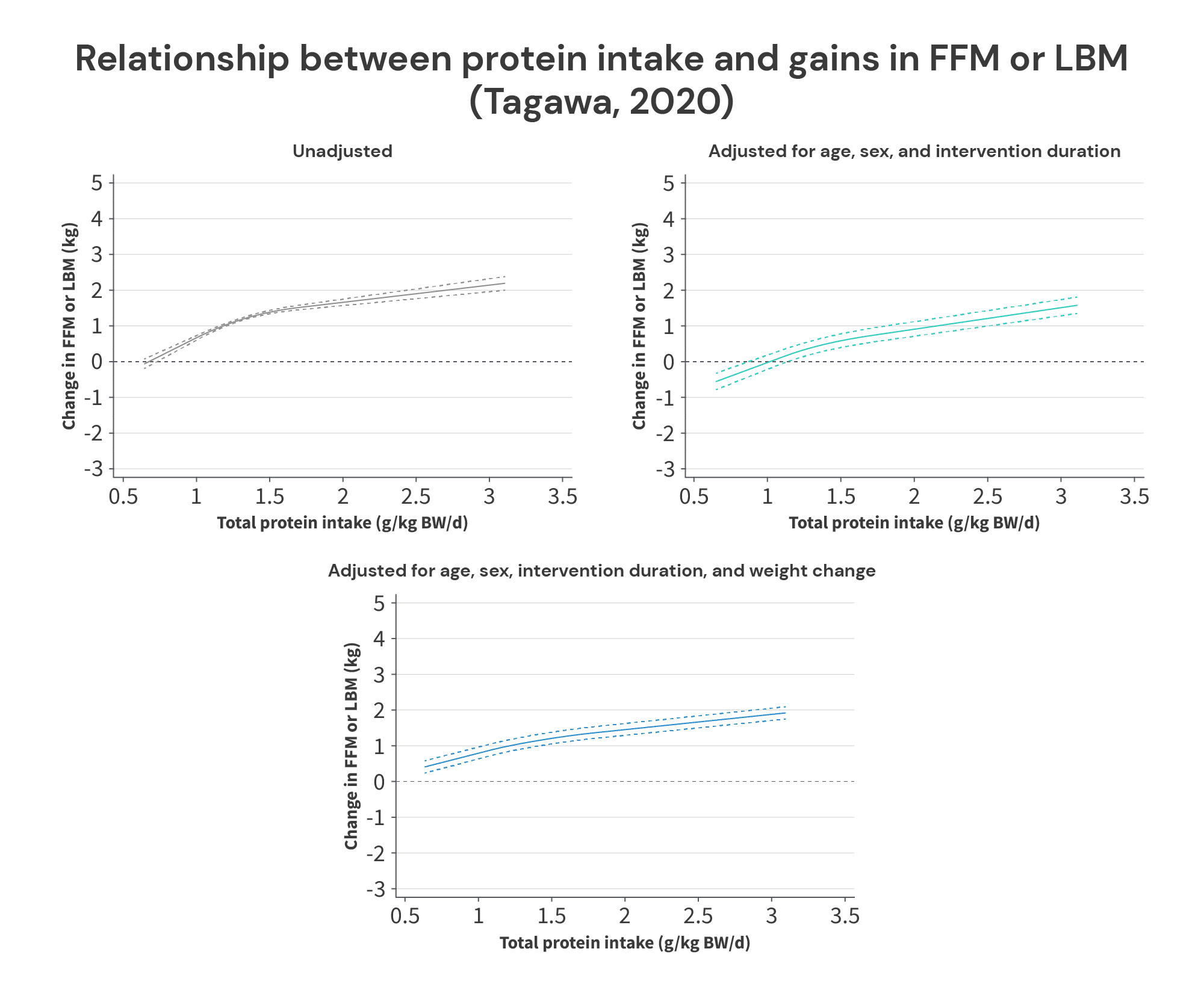

All of those fashions recommend that protein intakes exceeding 1.62g/kg result in additional will increase in FFM or LBM, and not one of the statistical changes have an effect on them that a lot. All three fashions recommend that will increase in protein consumption as much as about 1.3-1.5g/kg have a bigger affect than will increase in protein consumption past about 1.5g/kg, however the slope stays optimistic as much as consumption ranges of ~3g/kg (at which level, I assume the mannequin “stops” as a result of there weren’t sufficient research with even larger protein consumption ranges to trouble modeling).
I don’t have an excessive amount of extra so as to add concerning the Tagawa meta-regressions – they is likely to be nice, or they may depart loads to be desired. Sadly, the researchers didn’t describe the statistical procedures in sufficient element, or report sufficient supplementary analyses to know for certain.
Nonetheless, I did simply need to rapidly clear up a false impression I’ve seen floating round about this meta-regression. I’ve seen folks declare that weight reduction research strongly influenced its outcomes, as a result of most of the included research had been weight reduction trials with aggressive vitality deficits. Nonetheless, I’m unsure the place this concept got here from, as a result of it’s merely unfaithful. Out of the 105 research included within the meta-regressions (together with research each with and with out resistance coaching), 41 had been weight reduction research, 2 had been weight achieve research, and 62 didn’t embrace a purposeful weight achieve or weight reduction intervention. Moreover, of the resistance coaching research specifically, 9 examine arms aimed for weight reduction, 1 aimed for weight achieve, and 62 examine arms didn’t embrace a purposeful weight achieve or weight reduction intervention. So, about 86% had been upkeep research, and solely 12.5% had been weight reduction research. That is mirrored within the graphs above: changes for adjustments in physique weight had minimal affect on the meta-regression line for the analyses in lifters.
Lastly, the newest meta-analysis and meta-regression is from Nunes and colleagues, published in 2022. This one had inclusion standards that had been much like the Morton meta-regression from 2018 (wholesome adults, no weight reduction interventions, and so on.). It included 66 research investigating the affect of protein consumption on LBM or FFM, with a complete of 2665 topics.
It reported its leads to two methods. First, it reported the consequences of consuming <1.2 grams of protein per kilogram of physique weight (g = -0.14; p = 0.35), 1.2-1.59g/kg (g = 0.17; p <0.01), and ≥1.6g/kg (g = 0.30; p < 0.01).
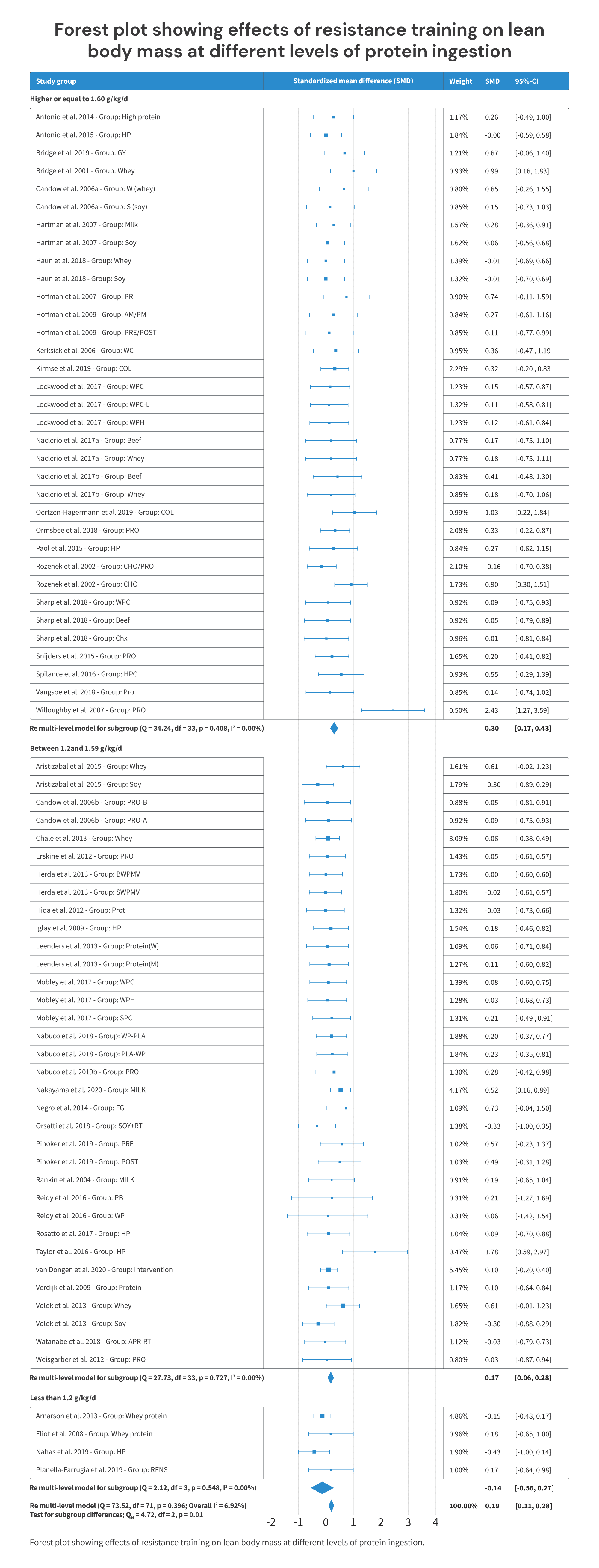

Second, it reported a steady evaluation (much like the breakpoint evaluation within the Morton paper, and much like the spline fashions within the Tagawa paper). Nonetheless, in contrast to the Morton paper (which got down to establish a particular breakpoint) or the Tagawa paper (which included a “knot,” or inflection level, within the spline mannequin), the Nunes paper simply presents the outcomes as a linear relationship:
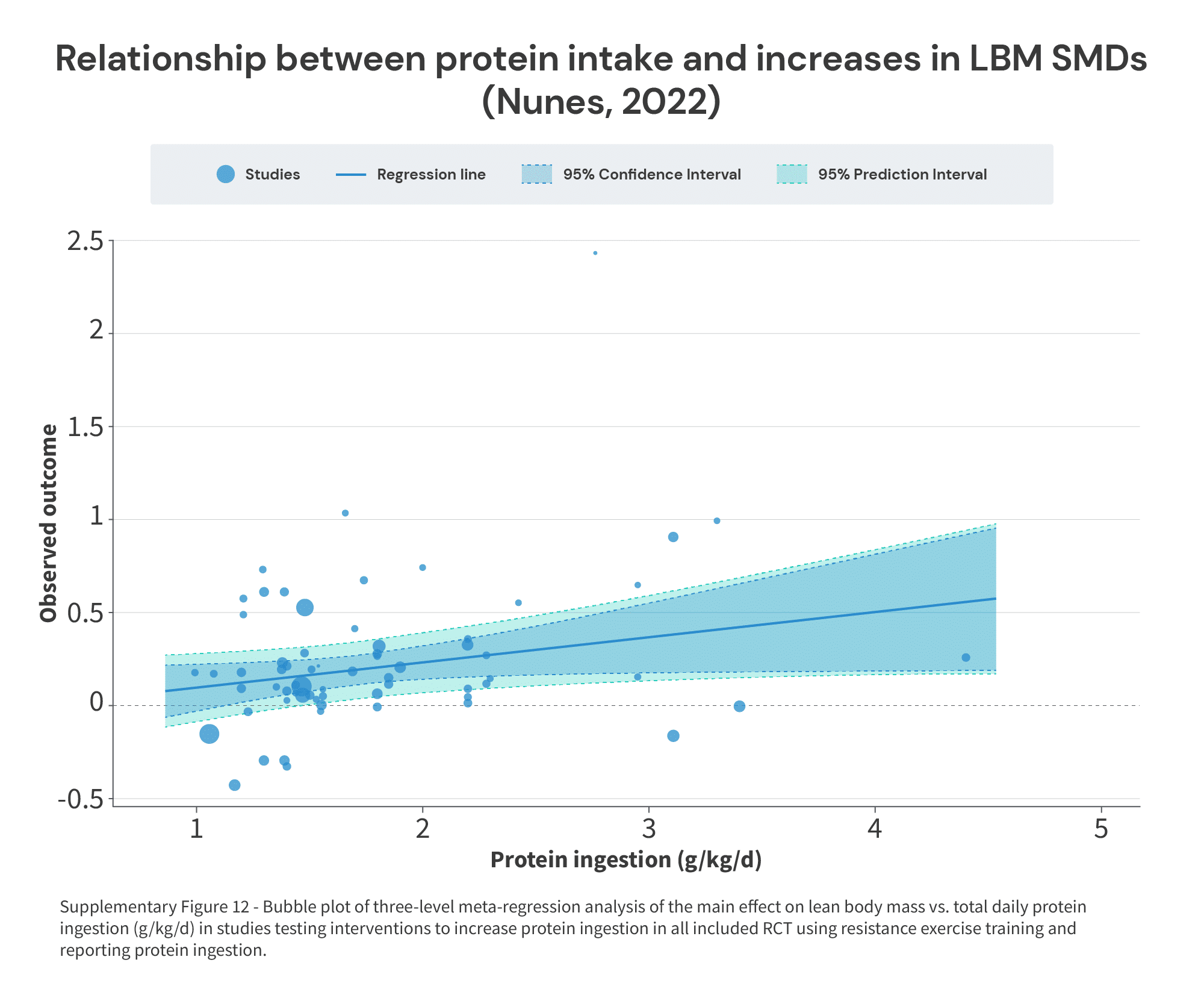

Now, if the impact of elevated protein consumption ultimately reaches the purpose of diminishing (or zero) returns, a linear evaluation isn’t going to have the ability to establish the place that time lies. Nonetheless, fortunately, Nunes and colleagues did a stellar job of sharing a supplementary desk with the traits of all the included research (Table S1), which we are able to cross-reference towards the impact sizes in Figure 2.
This let me construct a desk with the next info:
- The protein consumption of the low-protein group(s) in every examine
- The protein consumption of the high-protein group(s) in every examine
- The impact dimension for the comparability between protein consumption ranges
From there, I pooled protein intakes and impact sizes inside every examine to keep away from double-counting. For instance, in a study by Hartman and colleagues, there was one low-protein group consuming 1.56g of protein per kilogram of physique mass, and two high-protein teams – one consumed 1.8g/kg, and one consumed 1.65g/kg. Moreover, the impact dimension for one of many high-protein teams (describing the extent to which larger protein consumption coincided with bigger positive factors in FFM when evaluating the low-protein group to one of many high-protein teams) was 0.28, and the impact dimension for the opposite high-protein group was 0.06. So, as an alternative of extracting two comparisons from this examine (which might, in impact, depend the only low-protein group twice, because it was the purpose of comparability for each high-protein teams), it was collapsed down to at least one comparability: the low protein group consumed 1.56g/kg, and excessive protein teams consumed, on common, 1.725g/kg, and the common impact dimension was g = 0.17.
With this info, we are able to assemble a determine much like Supplementary Determine 3 from the Morton paper, in an try to establish the purpose at which additional will increase in protein consumption don’t reliably result in additional will increase in FFM or LBM:


Simply eyeballing this determine, two issues leap off the display screen at me. First, in most of the research the place the management teams devour an quantity of protein that’s throughout the ballpark of the “breakpoint” from the Morton meta-regression (the cluster of 8 research with management teams consuming between 1.55-1.8g/kg), additional will increase in protein consumption led to additional will increase in FFM/LBM. As soon as once more, this implies {that a} 1.62g/kg “breakpoint” is probably going too low. Second, the big impact close to the far proper of the chart actually stands proud.
That impact comes from a 2007 study by Willoughby and colleagues. This was a 10-week coaching examine, the place topics consumed both 40g of protein (28 grams of entire proteins + 12g of free amino acids) or 40g of dextrose every day. Topics within the placebo (dextrose) group averaged a protein consumption of two.06g/kg/day at the beginning of the examine, and a couple of.24g/kg/day on the finish of the examine. Topics within the intervention group averaged comparable protein intakes all through the day (2.15g/kg/day at the beginning of the examine, and a couple of.31g/kg/day on the finish) along with their every day protein complement. Counting the complement, their protein consumption reached 2.76g/kg/day on the finish of the examine.
This extra protein seems to have paid off. The placebo group gained 2.7kg of fat-free mass over the course of the examine, and the group receiving the protein complement gained 5.62kg of fat-free mass. Actually spectacular stuff!
Nonetheless, this examine is a pretty big outlier. It first caught my eye in a 2020 meta-analysis by Benito and colleagues, which merely aimed to quantify the everyday positive factors in LBM or FFM which are noticed in response to resistance coaching (it’s about 1.5kg in about 10 weeks, for anybody questioning). Out of the 111 research and 158 discrete teams included on this meta-analysis, mainly all the outcomes clustered between 0-3kg of LBM or FFM, with two exceptions: this examine by Willoughby (+5.62kg of FFM), and an exogenous growth hormone study by Deyssig and colleagues (+7.20kg of LBM). No different examine reported will increase that even reached 4.0kg (the subsequent highest was 3.9kg). So, that is actually a noteworthy discovering, however I’m going to exclude it from right here on out.
To go one step additional, we have to contemplate not simply the protein consumption of the low-protein teams in these research, but in addition the distinction in protein consumption between the low- and high-protein teams.
For instance, there is likely to be two research the place the placebo group consumed 1.5g/kg of protein, however in examine A, the high-protein group consumes 2.5g/kg of protein, and in examine B, the high-protein group consumes simply 1.6g/kg of protein. Within the chart above, each of those research would have the identical x-coordinate, nevertheless it shouldn’t be too stunning if larger protein intakes are related to bigger will increase in FFM in examine A, however not in examine B. Nonetheless, if all we plot is the protein consumption within the placebo group, we would marvel why it appears like will increase in protein consumption above 1.5g/kg result in giant positive factors in FFM in some research however not others. To right for this situation, a easy common can do the trick, because it incorporates details about the protein intakes of each the low-protein group and the high-protein group.
To additional account for the variations in protein consumption between teams, we are able to calculate impact dimension slopes. Within the instance above, we shouldn’t be shocked if rising protein by 0.1g/kg has a really small affect on FFM, and that rising protein by 1g/kg has a a lot bigger affect on FFM. However, if we divide the impact dimension by the distinction in protein consumption (in g/kg), we are able to get a standardized unit: impact dimension positive factors per 1g/kg of extra protein.
Right here’s a easy illustration: within the 2007 Hoffman study referenced beforehand, the low-protein group consumed 1.24g/kg, and the high-protein group consumed 2.0g/kg. The impact dimension was 0.74. So, a 0.76g/kg improve in protein consumption resulted in an impact dimension of 0.74. Thus, the impact dimension elevated by: 0.74/0.76 = 0.974 impact dimension items per 1g/kg improve in protein consumption, averaged over the vary of 1.24-2g/kg of protein consumption. The midpoint of the vary is 1.62g/kg. So, the purpose (1.62,0.974) would inform you the midpoint of the vary of protein intakes included within the examine, and the speed at which the impact dimension elevated all through that vary.
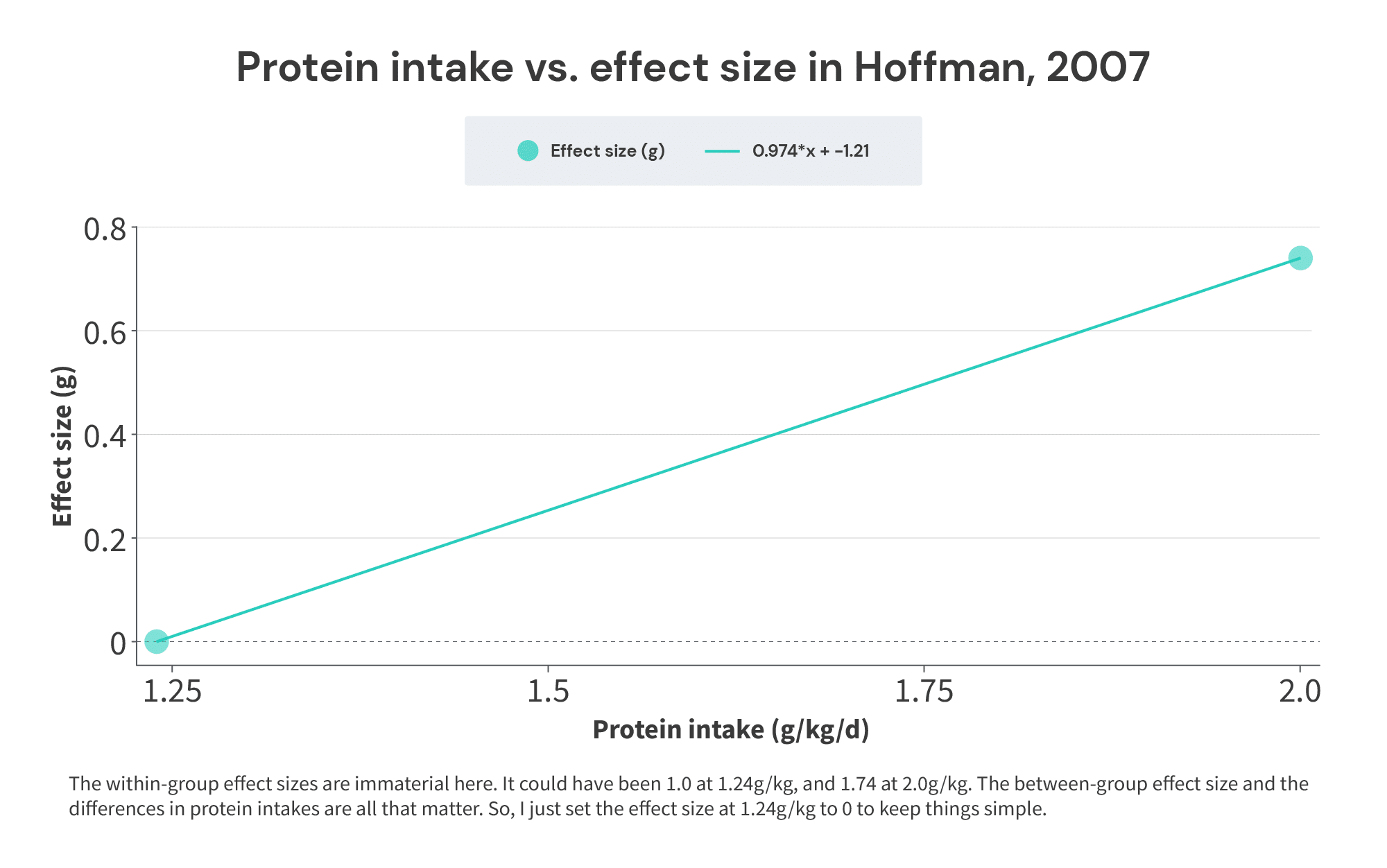



I notice this may occasionally appear pretty summary, nevertheless it ties again to the dialogue of Simpson’s Paradox from earlier. Simply to avoid wasting you a little bit of scrolling, these had been the theoretical research used for that illustration:


In Examine 1, we see that 1 set led to 4 extra items of hypertrophy than 3 units. So, over the vary of 1-3 units, rising quantity led to 2 extra items of hypertrophy per set (i.e., 2 items of hypertrophy per set could be the units vs. hypertrophy slope), and this charge of improve is centered on the midpoint (2 units) of the set vary used. So, we’d plot the purpose (2,2) for Examine 1. Comparable story for Examine 2 – every extra set led to 2 extra items of hypertrophy, however this time, the rise is centered at 3 units per week. So, we’d graph the purpose (3,2) for Examine 2. After we repeat this course of for all 8 research, we’d wind up with a graph that appears like this:
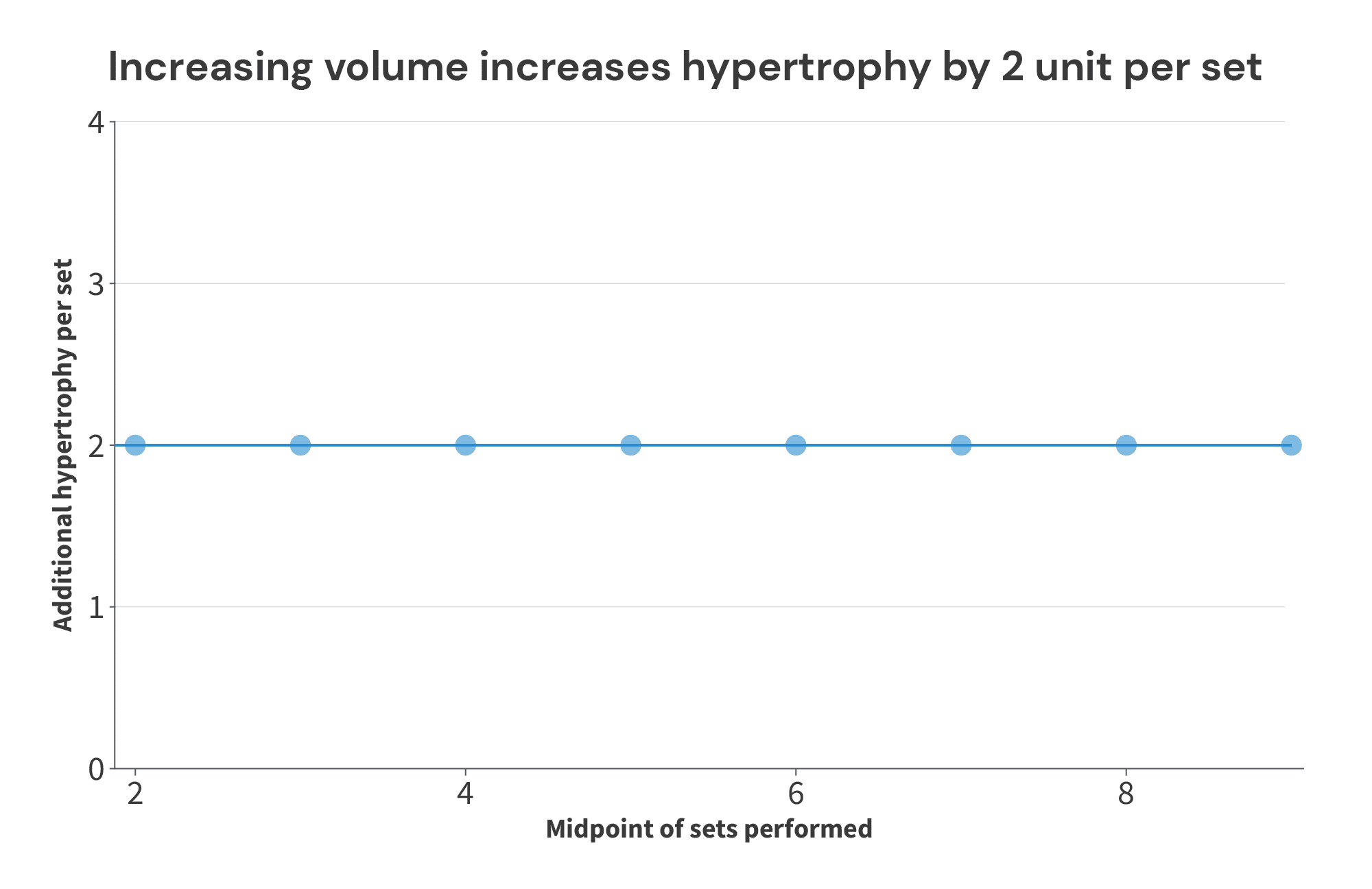

As you may see, this pretty and precisely describes the info. For all ranges of quantity studied, doing 2 extra units elevated muscle progress by 4 items. So, over the vary of volumes investigated in these theoretical research, every extra set yields 2 extra items of hypertrophy.
However now, let’s assume that there really is a breakpoint, the place rising quantity fails to result in additional will increase in muscle progress. As we’ll see, this methodology of plotting and analyzing slopes can really do a greater job of figuring out the breakpoint than merely plotting quantity carried out vs. hypertrophy noticed in every examine arm (as a result of once more, specializing in within-study variations helps negate variations between research and examine populations that additionally affect the end result of curiosity, unbiased of the affect of the intervention itself). As an example, I’ll use a brand new batch of theoretical research:


If we simply plot units carried out vs. hypertrophy noticed in every examine arm, we wind up with a graph that appears like this:
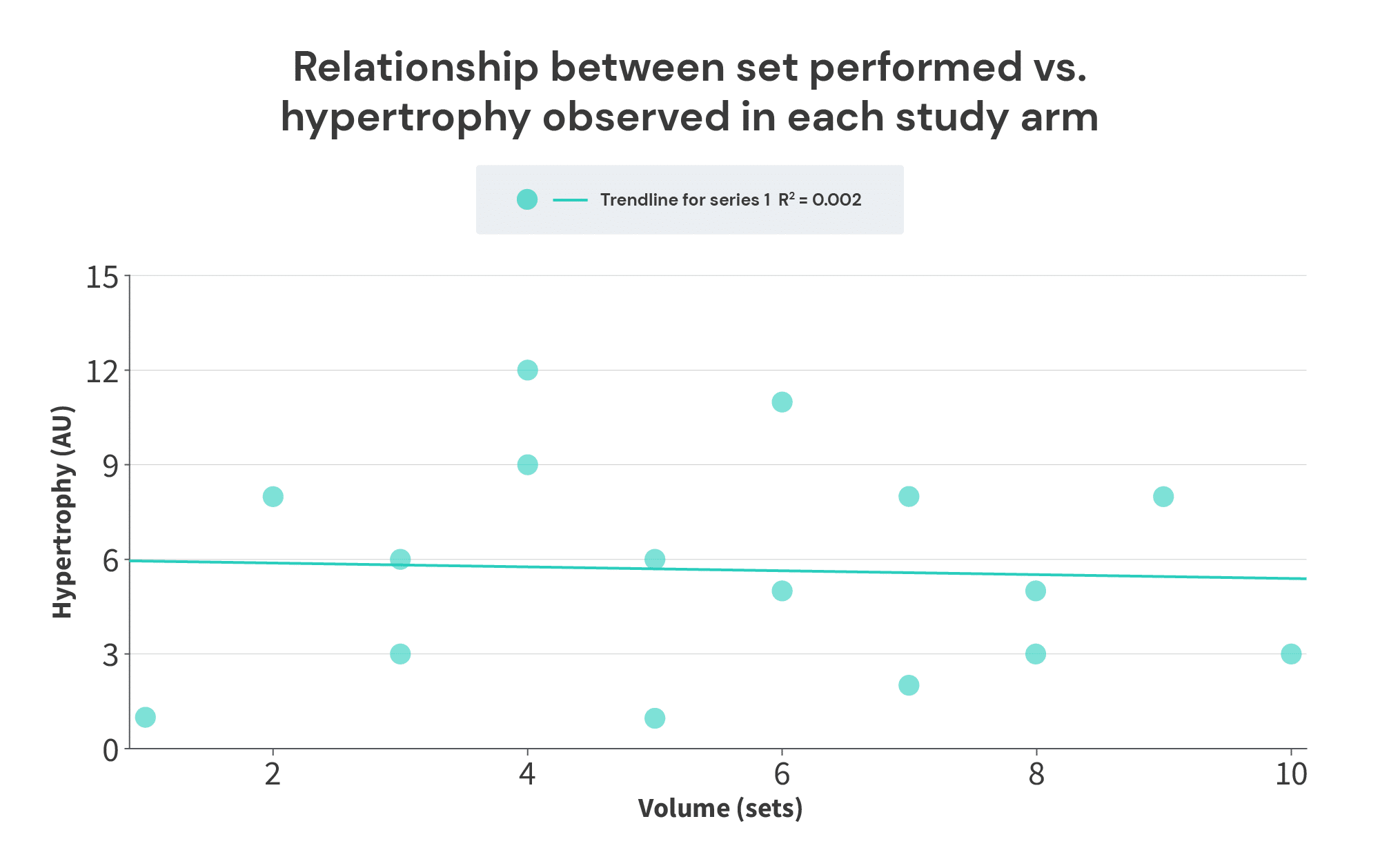

Not solely does there not seem like a breakpoint – there doesn’t seem like any relationship in any respect! Nonetheless, once we analyze the common set quantity carried out versus the quantity/hypertrophy slope inside every examine, the breakpoint turns into clear: extra will increase in quantity previous 7 units fail to result in extra progress:


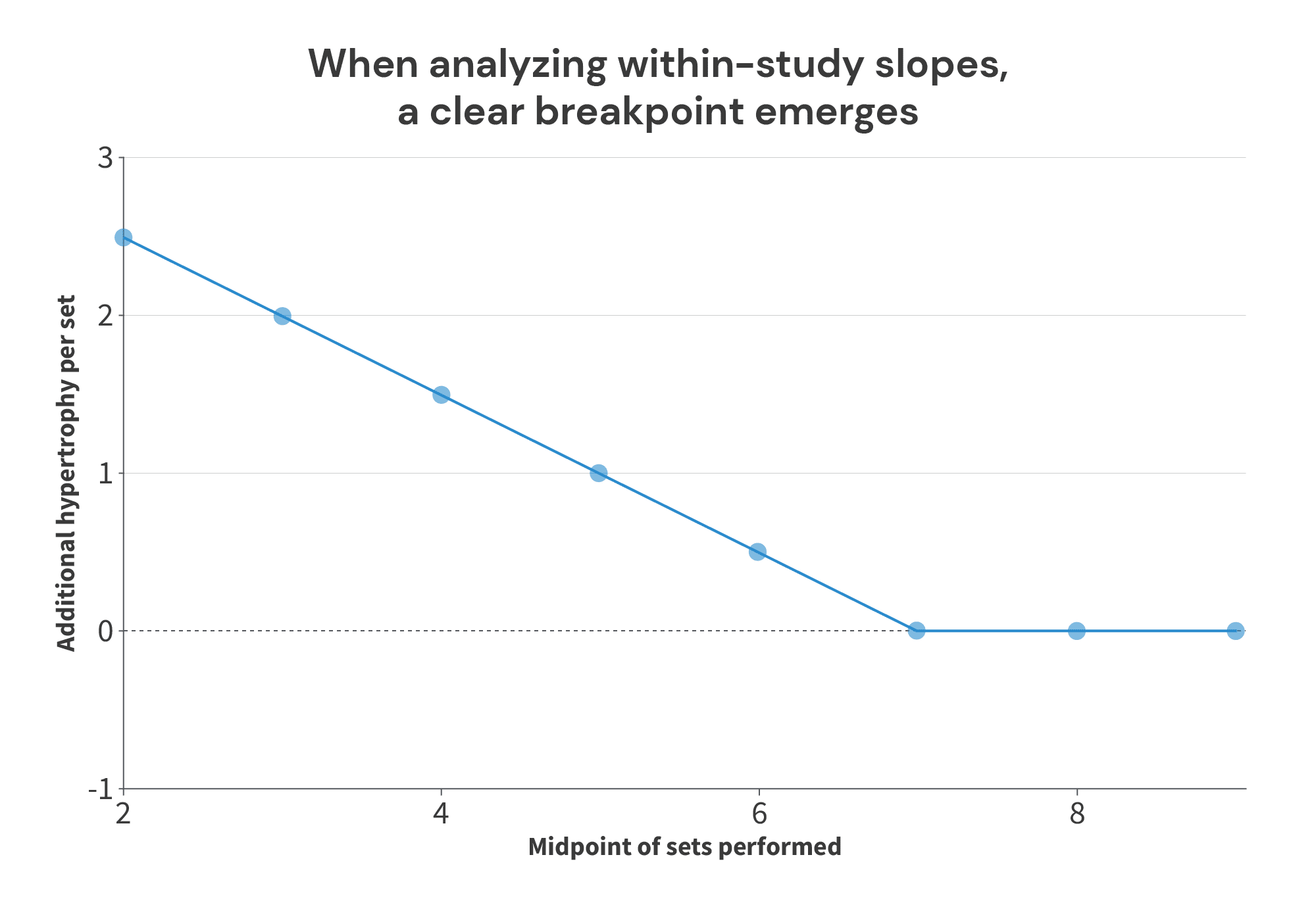

I notice that was fairly a little bit of windup and rationalization, however I simply wished to verify we’re all on the identical web page earlier than shifting forward. This part is pretty technical, and I do know that pondering when it comes to derivatives of the end result of curiosity (moderately than simply pondering when it comes to the end result of curiosity), or evaluating within-study variations within the end result of curiosity between research (moderately than simply evaluating the end result of curiosity between research) can really feel a bit unintuitive. So, that’s why I spent a bit extra time than regular on explaining and illustrating this idea. However, I believe it’s an vital idea to understand, as a result of I do really assume it is a higher method for figuring out the purpose previous which extra protein consumption fails to yield extra advantages.
So, with all of that out of the way in which, right here’s the info from the 50 research from the Nunes meta-analysis that had been amenable for this evaluation (the research that had been excluded had been research the place a protein complement was supplied, however complete protein consumption wasn’t reported):


*As talked about beforehand, the Willoughby examine is a pretty big outlier, so it gained’t be included within the graph under
Now, right here’s how the info appears when graphed:
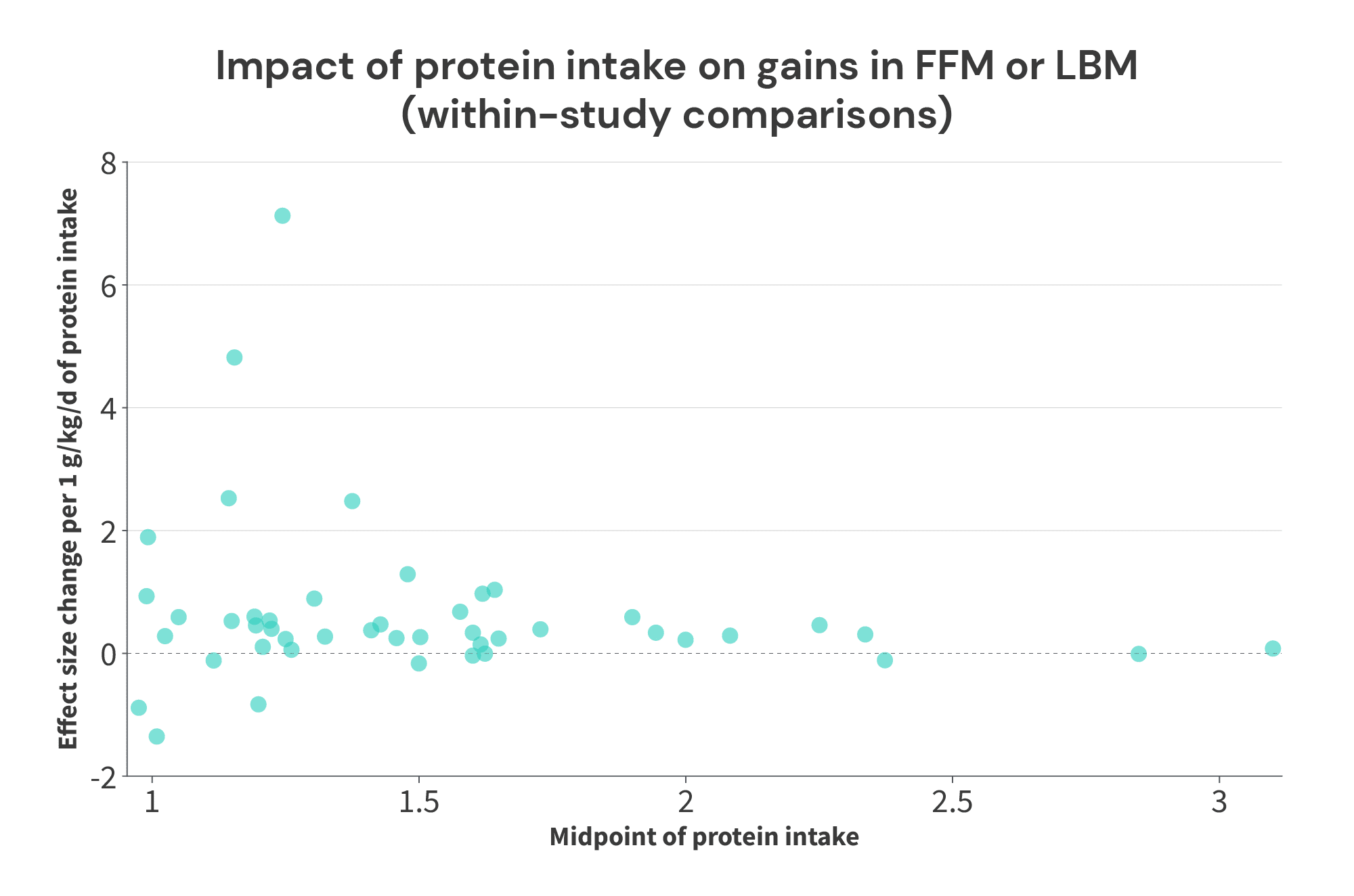

So, what can we see?
For starters, we actually see that the returns on rising protein consumption most likely get smaller as complete protein consumption will increase. The typical impact dimension slope with protein intakes under 1.5g/kg was 0.88, the common impact dimension slope with protein intakes of 1.5-1.99g/kg was 0.38, and the common impact dimension slope with intakes at or above 2g/kg was 0.19. So, in case you improve your protein consumption from 1.0 to 1.5g/kg, you’ll most likely get a fairly large payoff. Additional rising your protein consumption from 1.5 to 2.0g/kg would seemingly nonetheless yield advantages, however the advantages could be fairly a bit smaller. Additional will increase above 2.0g/kg should still yield some extra advantages, however the extra positive factors can be smaller but.
| The additive advantages of accelerating protein consumption lower at larger baseline ranges of protein consumption | |
| Protein consumption | Common impact dimension slope |
| <1.5g/kg/day | 0.88 |
| 1.5-1.99g/kg/day | 0.38 |
| ≥2g/kg/day | 0.19 |
Moreover, it seems that larger protein intakes are predictive of will increase in fat-free mass as much as round 2.3-2.4g/kg. In research the place the midpoint of protein intakes examined was under that time, we are inclined to see optimistic results with elevated protein intakes. Within the three research with even larger common protein intakes (Rozenek; Antonio, 2014; Antonio, 2015) we see impact dimension slopes of mainly zero (between -0.11 and 0.10).
Nonetheless, there are two vital issues to notice about this evaluation:
First, I did stack the deck in favor of discovering a “breakpoint” by excluding the Willoughby examine. Add that examine again into the combo, and the image adjustments dramatically. With the Willoughby examine included, the third largest impact noticed in any of those research comes from a paper the place a protein consumption of two.76g/kg beat the socks off of two.24g/kg (common protein consumption of two.5g/kg, with a slope of 4.67 impact dimension items per 1g/kg of protein consumption). At finest, you may predict that there might be a breakpoint someplace between 2.5g/kg and a couple of.85g/kg, however the image is actually loads murkier.
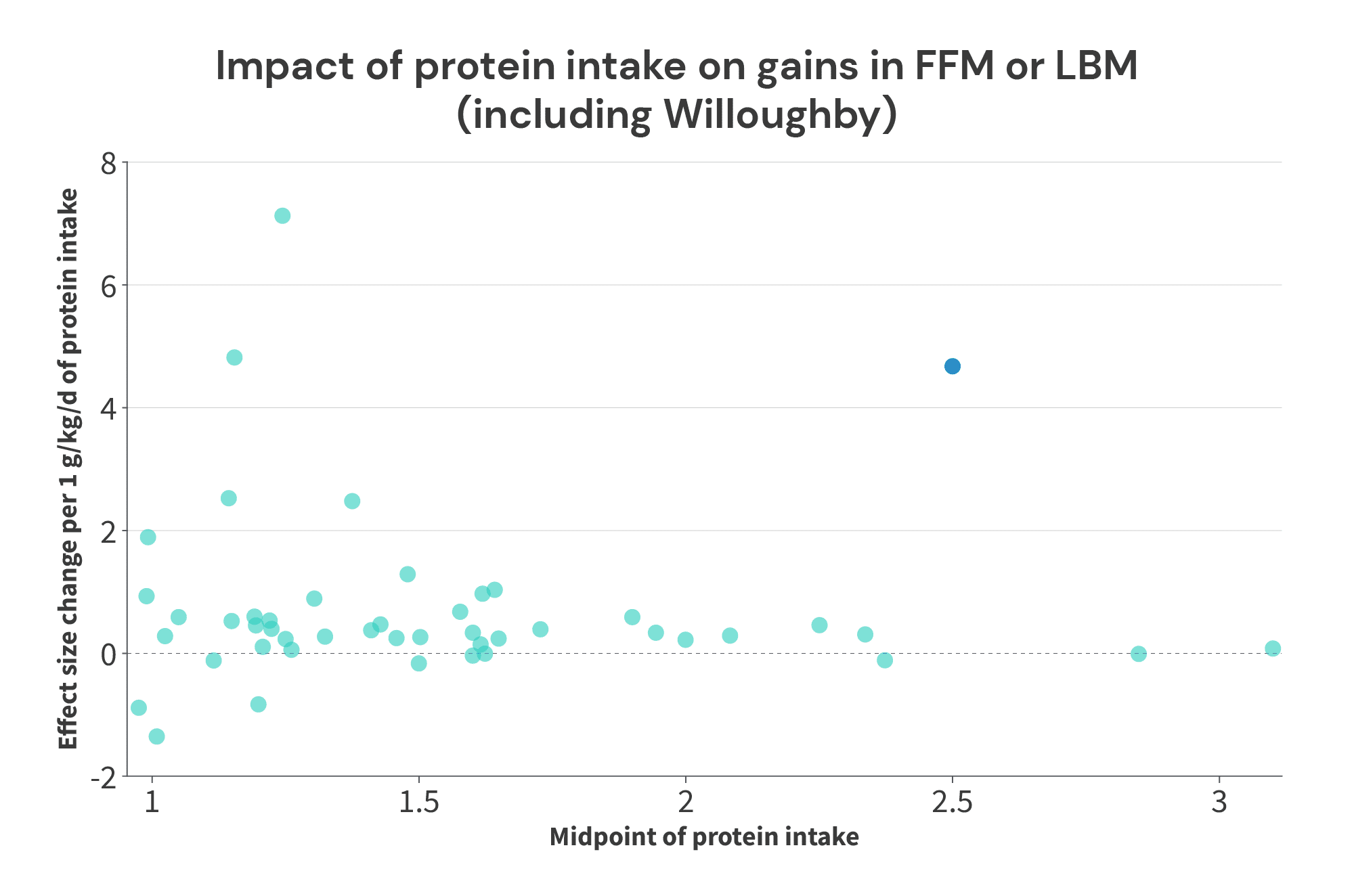

Second, this evaluation might introduce a optimistic bias if there may be really a breakpoint. As an example, let’s assume that protein intakes as much as 2.2g/kg do improve muscle progress, however there’s a tough cutoff at 2.2g/kg: additional will increase previous that time don’t yield additional advantages. On this state of affairs, you can have Examine A evaluating 1.8g/kg to 2.2g/kg, and Examine B evaluating 1.8g/kg to three.0g/kg. In each of those research, you’d anticipate to look at a optimistic impact, however the impact is completely pushed by the rise in protein consumption from 1.8g/kg to 2.2g/kg. The extra improve from 2.2g/kg to three.0g/kg wouldn’t yield extra advantages.
In examine A, you’d see a optimistic impact centered at 2.0g/kg, which is nice! Over the vary of 1.8-2.2g/kg, you ought to anticipate will increase in protein consumption to yield extra progress, so a optimistic impact centered at 2.0g/kg is spot-on.
Nonetheless, in Examine B, you’d see a optimistic impact centered at 2.4g/kg, which isn’t very best. With the good thing about understanding the assumptions behind this illustration, we all know that all the extra progress noticed with elevated protein intakes had been as a result of improve from 1.8g/kg to 2.2g/kg. The extra protein consumption (from 2.2g/kg to three.0g/kg) yielded no extra advantages. Nonetheless, we wouldn’t know that except we already knew there was a tough breakpoint at 2.2g/kg. So, we’d plot a optimistic impact at 2.4g/kg, which might make it seem that intakes above 2.2g/kg nonetheless had optimistic results on muscle progress.
So, the place does that depart us?
It really leaves us fairly shut to a tentative conclusion, with only one extra set of analyses. Beforehand, we plotted the connection between protein consumption in management teams, and the impact sizes related to will increase in protein consumption. Constructive results in that evaluation inherently imply that extra protein consumption can yield additional will increase in FFM. So, figuring out the place the optimistic results tail off can provide us an concept of the bottom believable worth for the breakpoint (i.e., it will seemingly underestimate the “true” breakpoint). Conversely, the evaluation I simply introduced could also be considerably positively biased in conditions the place a examine exams a degree of protein consumption that’s effectively past the breakpoint. So, figuring out the place the optimistic results tail off can provide us an concept of the very best believable worth for the breakpoint (i.e., it will seemingly overestimate the “true” breakpoint).
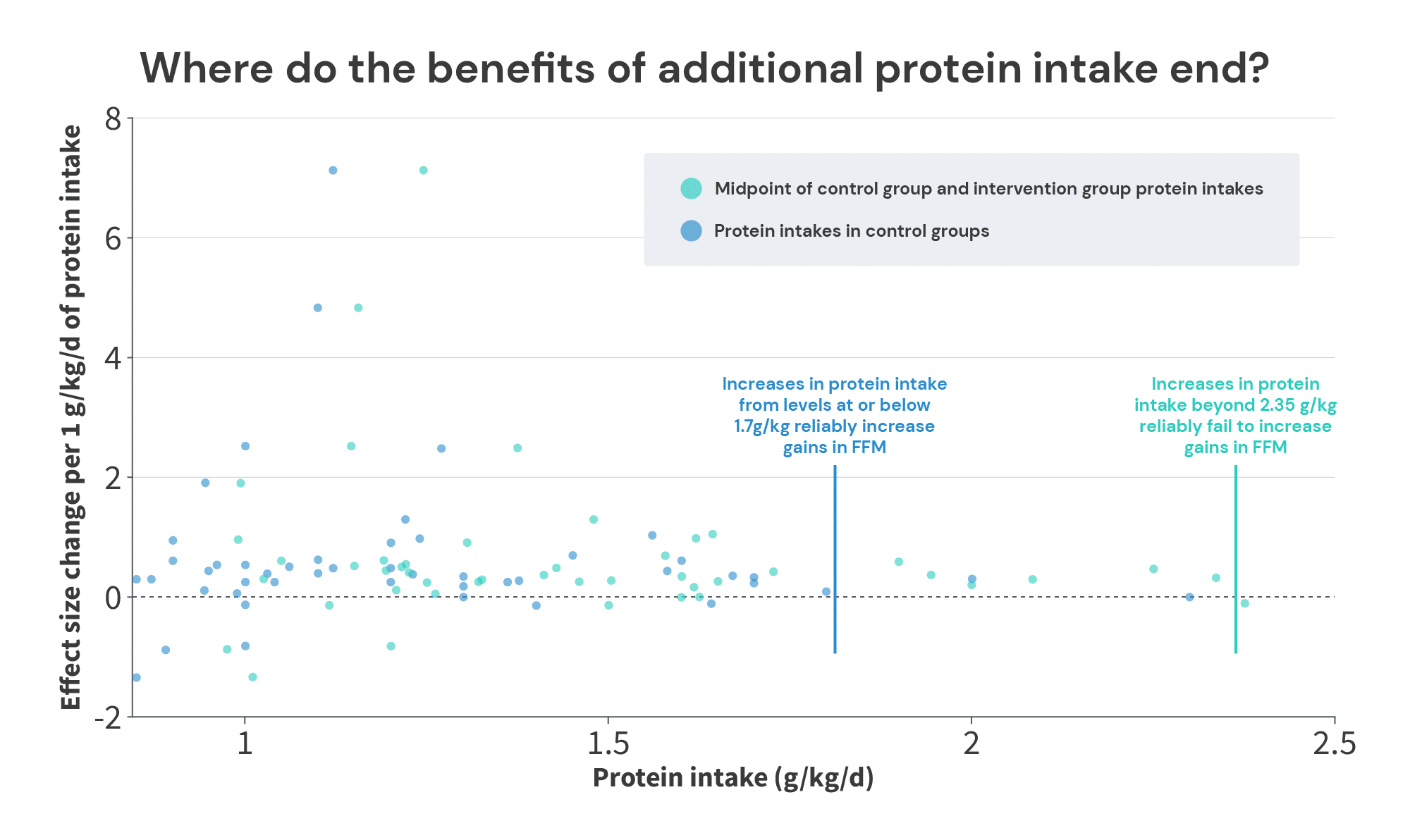

When wanting on the protein intakes and impact sizes within the management teams (blue dots), we see loads of optimistic results as much as 1.7g/kg, and we hit an impact of 0 at 2.3g/kg. So, the underside finish of the vary is someplace between 1.7g/kg and a couple of.3g/kg. The place you draw the road largely will depend on the way you view two research by Antonio and Sharpe.
Within the examine by Antonio, the management group consumed 1.8g/kg of protein, and the high-protein group consumed 4.4g/kg of protein for 8 weeks. On common, the high-protein group gained 0.6 extra kilos of fat-free mass, in comparison with the management group (1.9 vs. 1.3kg). Nonetheless, this examine was poorly managed – the themes had been already well-trained lifters (with a mean of almost 9 years of coaching expertise, coaching for a mean of 8.5 hours per week), and the researchers merely instructed them to stay to their regular coaching habits at some stage in the examine. I perceive the choice; it’s notoriously tough to get critical lifters to show their coaching over to a crew of researchers for an prolonged time period. And, in case you wished to design and monitor standardized exercises that may roughly match the themes’ regular coaching habits, that may introduce a big topic burden, and it will imply you’d want analysis assistants to manage round 2000 complete hours of exercises. So, there’s one thing to be stated for the pragmatism and ecological validity of the examine design (within the “actual world,” in case you suggest that individuals improve their protein consumption, they’ll be rising their protein consumption whereas persevering with with their present coaching habits), nevertheless it does make it more difficult to conclude that the variations between teams had been solely attributable to the variations in protein consumption.
Within the study by Sharpe, topics in 4 teams accomplished a standardized 8-week coaching program. One group (the management group) obtained a maltodextrin complement, and the opposite three teams all obtained protein dietary supplements (whey, beef, or hen protein). The three protein complement teams all achieved bigger positive factors in lean physique mass than the management group (1.0kg within the management teams, versus 2.4, 1.9, and a couple of.1kg within the three complement teams), even if the management group was already consuming 2 grams of protein per kilogram of physique mass. Nonetheless, it was an industry-funded examine from a analysis group that had a particularly notorious track record for reaching eye-popping (maybe even credulity-straining) leads to industry-funded complement research.
So, the place you set the decrease boundary is a little bit of a judgment name, relying on the way you view these two research. You’d be completely justified in inserting it at 1.7g/kg (since we see a couple of examples of will increase past 1.7g/kg yielding additional progress, however you could not really feel completely assured concerning the research discovering extra progress with intakes past 1.8g/kg and a couple of.0g/kg). Or, you can make a case for two.3g/kg in case you have an optimistic view of the lab that produced the Sharpe examine, and the shortage of coaching controls within the Antonio examine don’t trouble you. Personally, I’m pleased to be conservative and place the decrease boundary at 1.7g/kg.
The higher boundary is extra easy. We see constant optimistic results with common protein intakes (the midpoint between the high and low consumption in every examine) up to 2.34g/kg (in a examine by Candow and colleagues), and our first unfavourable impact with common intakes at 2.38g/kg (in a examine by Rozenek and colleagues).
Now, in case you wished to quibble, you can argue that the Rozenek study was an aggressive weight achieve examine in completely untrained lifters, so its outcomes might not be relevant. Topics in two teams had been instructed to take care of their regular diets, whereas additionally consuming a ~2000 Calorie supplemental shake every day. The shake for one group consisted primarily of extra carbohydrate, and the shake for the opposite group was a carbohydrate/protein mix. The topics in each of those teams gained about 3kg of physique mass with just about no change in fats mass – the themes within the carbohydrate group simply gained barely greater than 3kg of FFM, and the themes within the protein/carbohydrate group simply gained barely lower than 3kg.
However, you might have a look at the outcomes and conclude that protein consumption was by no means going to be a limiting issue within the first place: these topics had been able to develop like weeds, and simply wanted extra energy from any supply to gas their positive factors. Since they barely gained any fats, you can make the case that extra protein shouldn’t have been anticipated to affect their outcomes except they elevated their vitality consumption much more, and tried to bulk even sooner, till reaching the purpose that protein consumption turned a limiting constraint (so, in impact, you’d hypothesize that the speed at which the themes might achieve weight with out gaining fats could be better with larger protein intakes). Or, you can merely argue that protein consumption necessities are decrease in an vitality surplus than at (roughly) energetic upkeep, and since this was the one examine that included an intentional, giant vitality surplus, it needs to be disregarded for that cause.
I personally don’t discover both of these arguments to be notably persuasive. They sound logical, however they’re each predicated on a number of untested assumptions. I’m way more snug coping with outcomes from research which have really occurred, moderately than the assumed outcomes of barely totally different research that haven’t really occurred.
So, I’m going to tentatively place the higher finish of the believable vary for the breakpoint (the purpose previous which extra protein consumption fails to additional improve muscle progress) at 2.35g/kg.
So now, the second of reality: at what level does rising protein consumption fail to result in extra will increase in fat-free mass or lean physique mass?
The well-known Morton meta-analysis advised that the breakpoint is at 1.62g/kg, with a believable vary for the breakpoint spanning from 1.03-2.2g/kg. This has been distilled right down to the advice that lifters ought to goal for 1.62g/kg, and a couple of.2g/kg is a “higher secure than sorry” consumption.
Nonetheless, my finest accounting of this physique of analysis means that the almost definitely breakpoint (if one exists) is at round 2.0g/kg, with a believable vary for the breakpoint spanning from 1.7-2.35g/kg. So, in case you distilled it down in the identical method, you’d suggest that lifters ought to goal to devour between 2.0g/kg and a couple of.35g/kg of protein.
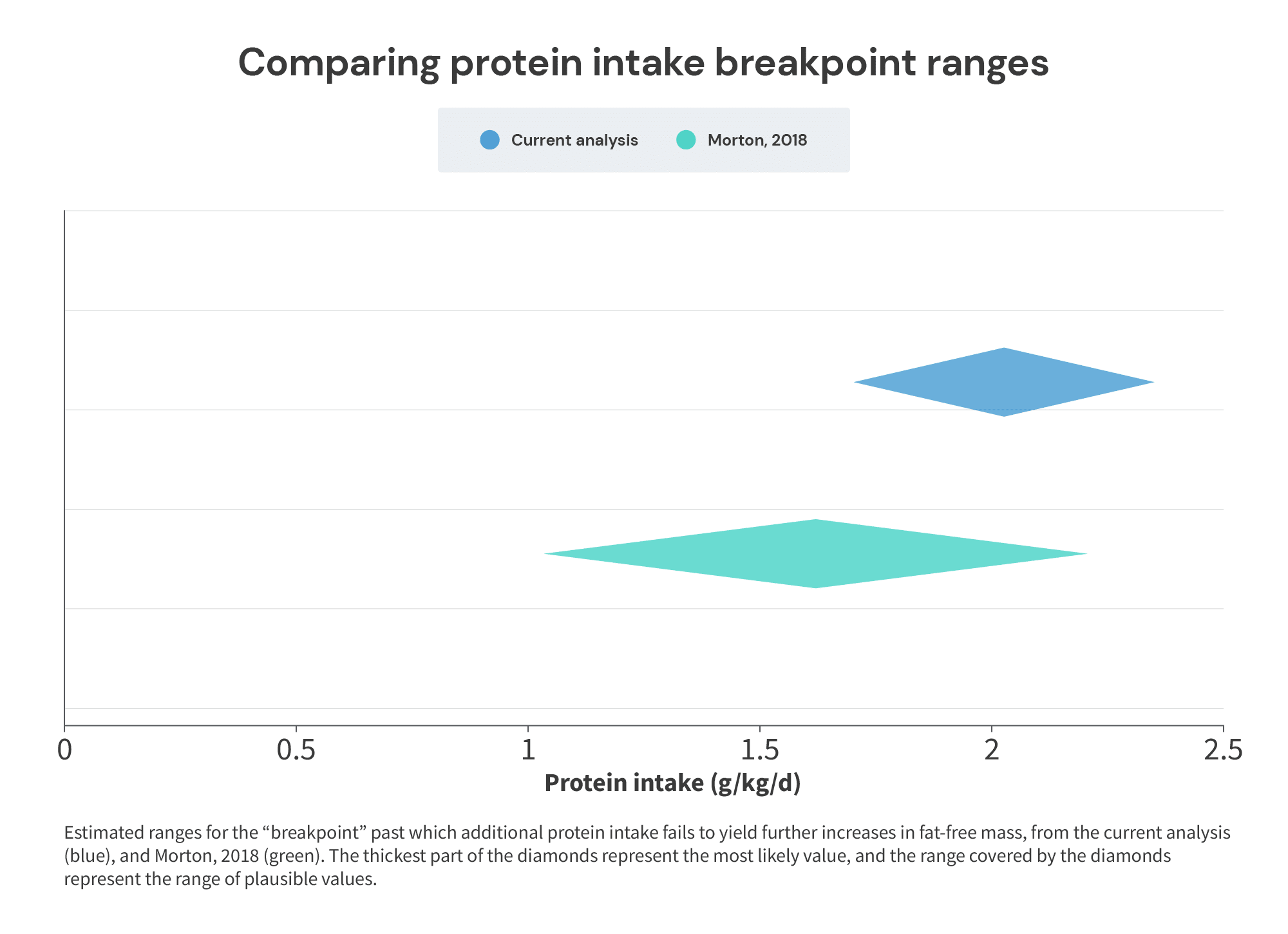

However wait, there’s extra!
There’s a well-known quip, most regularly utilized to economists: “Certain, it really works in apply, however does it work in idea?”
So far, I’ve targeted completely on analysis investigating longitudinal outcomes: when folks devour differing quantities of protein for an prolonged time period, at what level can we cease observing variations in fat-free mass accretion?
Nonetheless, it will even be extraordinarily handy if protein suggestions derived from longitudinal research had been much like protein suggestions derived from acute research that estimate every day protein necessities. If, for example, acute research advised that solely 1g/kg of protein is required to maximise every day protein steadiness, or in the event that they advised that 3g/kg is required to maximise every day protein steadiness, we’d have a small conundrum on our fingers. However, if acute and longitudinal research settle at comparable values, that concordance would enable us to have significantly extra confidence within the ensuing suggestions.
Beforehand, nitrogen steadiness research had been the gold commonplace for estimating protein necessities acutely. In a nitrogen steadiness examine, researchers present meals containing a identified quantity of nitrogen (i.e. protein) to topics. Then, after a two-week interval of consuming a hard and fast quantity of nitrogen, the researchers accumulate the themes’ urine and feces for 3-5 days, since most nitrogen is both misplaced within the feces, or excreted within the urine. Then they repeat this course of with a number of different ranges of nitrogen consumption (two weeks of fixed nitrogen feeding, with 3-5 days of urine and feces assortment). Lastly, they measure the nitrogen current within the urine and feces at every degree of nitrogen consumption, with the aim of estimating when nitrogen steadiness is the same as zero (i.e., the purpose at which nitrogen excretion equals nitrogen consumption).
Nonetheless, nitrogen steadiness research have a number of drawbacks.
The primary is just that they’re costly, time-consuming, and … slightly gross. If you wish to take a look at three ranges of protein consumption, every topic has to take part and adjust to the take a look at diets for six weeks, the researchers have to offer meals to every topic for six weeks, the themes want to gather all of their pee and poop for 9-15 days in complete, and the researchers must course of quite a lot of pee and poop (and typically sweat) from all the topics.
The second downside is that the researchers aren’t going to have the ability to accumulate all the nitrogen excreted. Whereas urine and feces account for >95% of nitrogen excretion, the physique additionally excretes nitrogen by the pores and skin (ammonia in sweat), by way of exhalation (additionally ammonia), and thru hair, nails, saliva, mucous, and semen. So, you essentially must make some assumptions about how a lot nitrogen you’re not amassing to be able to estimate complete nitrogen steadiness.
The third main downside compounds the second downside: the road between nitrogen steadiness and imbalance could be very tough to establish, as a result of complete nitrogen consumption and complete nitrogen excretion are merely a lot bigger values than the distinction between consumption and excretion. As an example, in case you’re in a state of slight nitrogen imbalance, you may devour 16,000mg of nitrogen per day (the quantity of nitrogen in roughly 100g of protein) and excrete 15,500mg of nitrogen per day, for a distinction of simply 500mg (i.e., the distinction is almost two orders of magnitude smaller than the consumption and excretion values). So, if topics are consuming barely kind of nitrogen than researchers assume, or if assumptions about unmeasured nitrogen losses are off by a reasonably small quantity, you can simply be at nitrogen steadiness when information suggests you’re nonetheless in a nitrogen deficit, or your precise nitrogen deficit is likely to be twice as giant as your information suggests.
The fourth main downside is that the nitrogen steadiness approach is identified to overestimate nitrogen consumption and underestimate nitrogen losses. The upshot is that the degrees of protein consumption which are really required to attain nitrogen steadiness are larger than the protein consumption ranges advised by the nitrogen steadiness approach. To cite a review paper from Tomé and Bos, “it’s effectively acknowledged that the nitrogen steadiness approach overestimates N consumption and underestimates N losses. That is primarily as a result of problem in assessing N fuel losses after denitrification by the colonic microflora, N losses by the pores and skin (urea) and expired air (ammonia) and the nitrate content material in meals and urine, which isn’t measured utilizing the Kjeldahl methodology.”
The fifth main downside – a minimum of for lifters – is that the nitrogen steadiness approach assumes that positive nitrogen balance is merely an artifact within the absence of serious weight achieve. In different phrases, the approach isn’t designed to estimate the purpose at which charges of nitrogen accretion are maximized. It’s merely designed to estimate how a lot nitrogen it’s essential to devour to not lose lean tissue. Now, to be clear, even once you’re constructing muscle pretty rapidly, you shouldn’t anticipate to be in massively optimistic nitrogen steadiness. Let’s assume a brand new lifter gains 1.5kg of muscle in 10 weeks. About 20% of a muscle’s weight comes from protein, and protein is about 16% nitrogen by mass. So, constructing 1.5kg of muscle would require a complete of 240,000mg of internet nitrogen accretion, at a charge of about 685mg of nitrogen per day. At physique weights starting from 60-100kg, this charge of muscle progress would subsequently require nitrogen accretion to happen at a charge of ~6.5-11.5mg/kg/day. When in comparison with a typical every day nitrogen flux of ~150-400mg/kg/day, such a small internet optimistic steadiness could be just about inconceivable to measure precisely. However, it’s value emphasizing that nitrogen steadiness research, by design, implicitly assume that obvious internet nitrogen accretion is merely an artifact or a measurement error in most contexts. They’re not concerned about figuring out the extent of protein consumption required to maximise internet protein anabolism – they’re merely concerned about figuring out the extent of protein consumption required to keep away from internet protein catabolism.
There’s now a significantly better approach for estimating protein necessities, which I’ll talk about in a second. However, you could be curious why I spent a lot time discussing the drawbacks of an outdated approach, if I’m not going to finish up utilizing nitrogen steadiness research to attract inferences about acute protein wants. The reason being easy: some proponents of decrease protein intakes lean closely on nitrogen steadiness research (whereas additionally nonetheless referring to nitrogen steadiness as an “unreliable methodology”) to help their rivalry that comparatively low protein intakes are required to maximise muscle progress: one, two, three, four, five, six, seven.
So, nitrogen steadiness isn’t an awesome approach, however what’s higher?
The Indicator Amino Acid Oxidation (IAAO) methodology is usually a superior methodology for estimating protein necessities. It’s based mostly on a easy precept: your physique will oxidize amino acids it might’t use. In brief, topics devour various quantities of protein, however the consumption of a single amino acid (often phenylalanine) is held at a relentless, elevated degree. Whenever you’re not consuming very a lot protein, total ranges of protein synthesis are decrease, so you employ little or no of the indicator amino acid, and find yourself oxidizing the indicator amino acid at a excessive charge. As protein consumption will increase, protein synthesis additionally will increase, so you should utilize extra (and oxidize much less) of the indicator amino acid. Nonetheless, when you attain the purpose at which additional will increase in protein consumption fail to yield additional will increase in protein synthesis, oxidation charges of the indicator amino acid plateau.
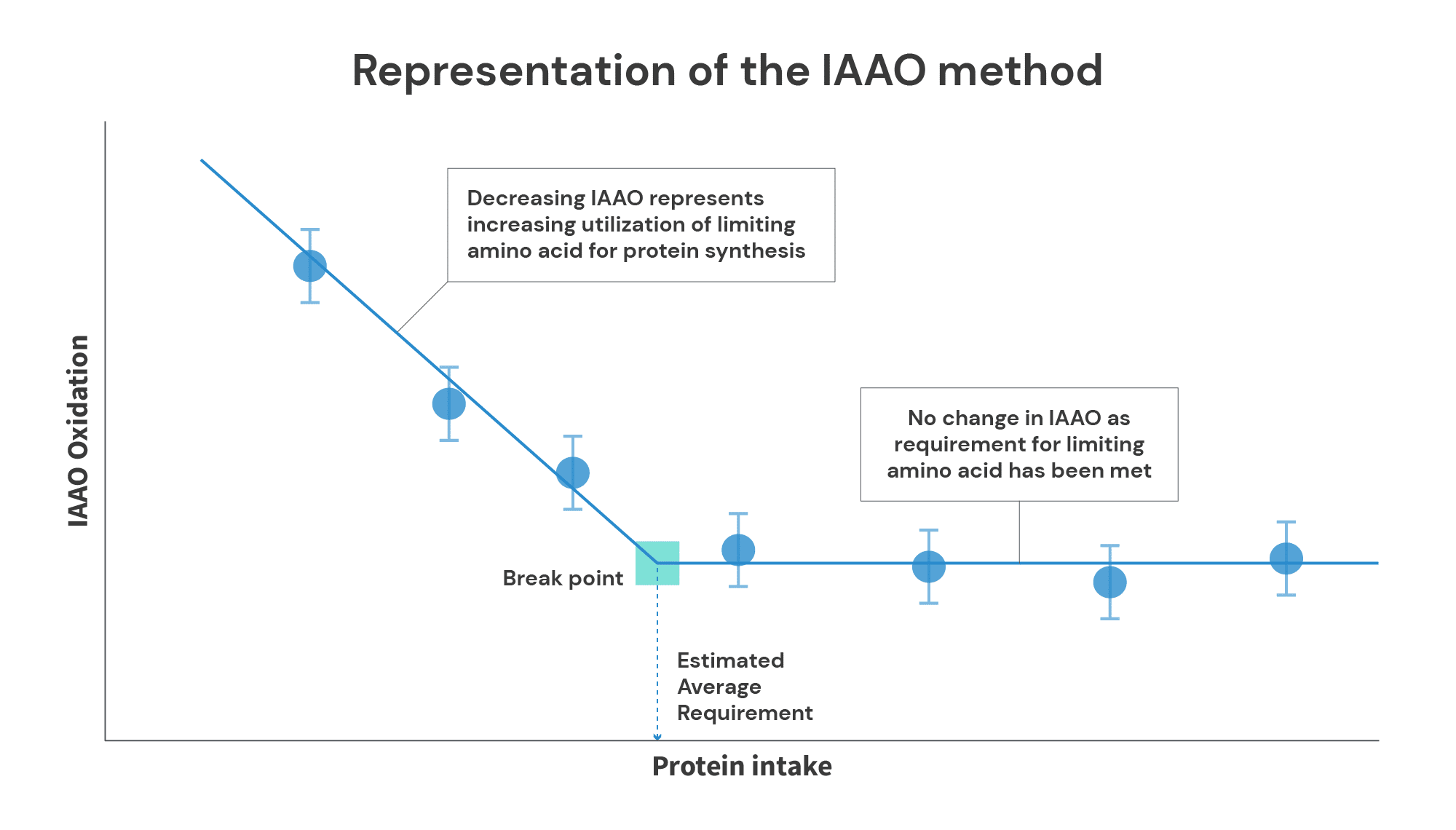

The IAAO methodology has a number of advantages over the nitrogen steadiness methodology.
First, the burden on each topics and researchers is decrease. Every degree of protein consumption will be examined in three days (one testing day and two washout days) moderately than two weeks. Moreover, topics don’t have to gather their urine and feces, and researchers don’t must course of a great deal of urine and feces.
Second, you don’t want to fret about making a ton of assumptions about routes of nitrogen excretion you may’t instantly measure. With the IAAO methodology, it doesn’t matter if the protein you oxidize winds up in your urine, your sweat, or your hair – all it’s essential to know is the purpose at which the oxidation charge of your indicator amino acid plateaus.
Third, the IAAO methodology doesn’t depend on the belief that internet protein accretion is (primarily) inconceivable. If a person isn’t able to being in internet optimistic protein steadiness, oxidation charges of the indicator amino acid will plateau at a degree of protein consumption comparable to internet impartial protein steadiness. If a person is able to being in internet optimistic protein steadiness (i.e., in the event that they’re in a state the place protein synthesis exceeds protein breakdown), oxidation charges of the indicator amino will (or a minimum of ought to) plateau on the degree of protein consumption that maximizes the speed of internet protein accretion.
Nonetheless, one small potential downside of IAAO research is that they could nonetheless barely underestimate protein necessities. The protein combination utilized in IAAO research sometimes has the amino acid composition of eggs, and egg protein is one of the highest-quality proteins (which means it’s simply digested, and has an amino acid composition that’s conducive for maximizing protein synthesis). In a typical weight loss plan, which incorporates a mixture of higher- and lower-quality proteins, it’s potential that barely larger ranges of complete protein consumption could be required to maximise anabolism.
So, what do IAAO research inform us about optimum protein intakes?
For starters, they inform us that nitrogen steadiness research seemingly considerably underestimate human protein wants. This shouldn’t be too stunning (bear in mind, nitrogen steadiness research sometimes overestimate nitrogen intake and underestimate nitrogen excretion), however the dimension of the distinction is pretty stunning.
The RDA (Really helpful Dietary Allowance) for protein of 0.8g/kg got here from an analysis of nitrogen balance studies. These research advised that the common protein consumption required for folks within the basic inhabitants to attain nitrogen steadiness was 0.66 ± 0.085 grams of protein per kilogram of physique mass. An RDA is meant to cowl the wants of 95% of people, so to calculate an RDA, you add two commonplace deviations to the common requirement. Thus, the RDA for protein was calculated to be 0.83g/kg, which the USDA rounded right down to 0.8g/kg (the World Well being Group additionally adopted a similar approach).
Nonetheless, IAAO studies in the general population typically discover that the common protein consumption requirement is round 0.92g/kg, and the protein consumption required to cowl the wants of 95% of people is round 1.2g/kg. So, nitrogen steadiness research seemingly underestimated protein necessities within the basic inhabitants by ~40-50%! There’s each cause to suspect that the aforementioned nitrogen steadiness research in lifters additionally underestimated protein necessities to an analogous diploma.
Now, what do IAAO research must say concerning the protein necessities for lifters?
We presently have three relevant research: a 2017 study by Bandegan and colleagues checked out protein necessities for male bodybuilders on a non-training day, a 2019 study by Malowany and colleagues checked out protein necessities for resistance-trained females on a coaching day, and a 2020 study by Mazzulla and colleagues checked out protein necessities for resistance-trained males on a coaching day.
The Bandegan study discovered that the common protein consumption required to maximise anabolism was 1.7g/kg of complete physique mass (2g/kg of fat-free mass), and the protein consumption required to maximise anabolism in 95% of people was 2.2g/kg of complete physique mass (2.5g/kg of fat-free mass).
The Malowany study discovered that the common protein consumption required to maximise anabolism was 1.49g/kg (2.13g/kg of fat-free mass), and the protein consumption required to maximise anabolism in 95% of people was 1.93g/kg (2.78g/kg of fat-free mass).
Lastly, the Mazzulla study discovered that the common protein consumption required to maximise anabolism was 2.0g/kg (2.35g/kg of fat-free mass), and the protein consumption required to maximise anabolism in 95% of people was 2.38g/kg (2.9g/kg of fat-free mass).
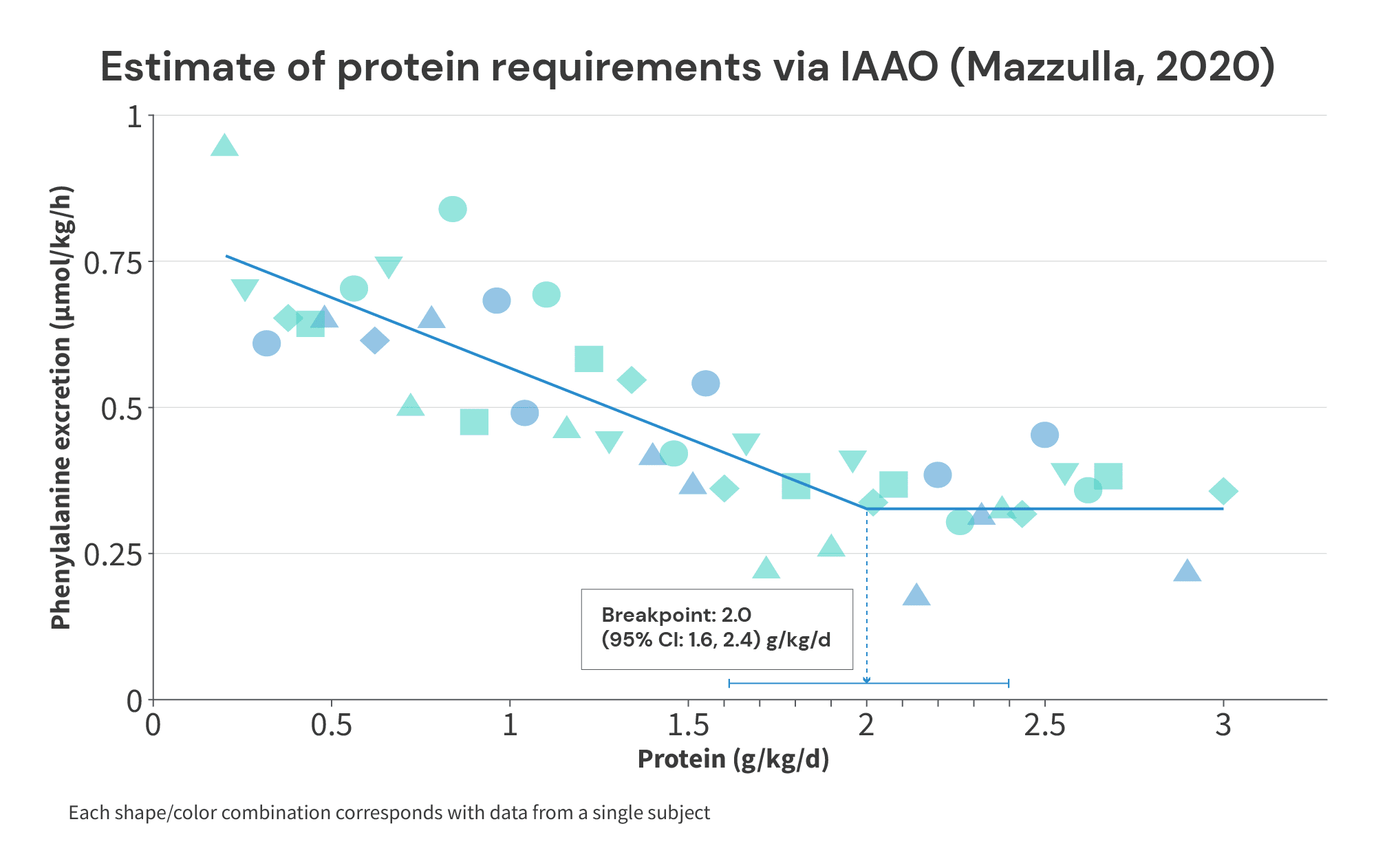

Of notice, these values evaluate favorably with the vary of believable breakpoints we derived from the longitudinal research above. If you happen to’ll recall, I advised {that a} protein consumption of a minimum of 1.7g/kg is required to maximise muscle progress, with the believable vary extending as much as 2.35g/kg. In these research, we’re seeing common necessities of 1.49-2.0g/kg (which appear to be neatly clustered round 1.7g/kg), with the very best advice for maximizing anabolism in 95% of people stretching as much as 2.38g/kg (suspiciously near 2.35g/kg).


So, not solely does a protein breakpoint of round 2.0g/kg (someplace between 1.7-2.35g/kg) work in apply – it additionally seems to work fairly effectively in idea.
However, whereas I’ve you right here, I do have a pair extra fast notes.
First, a re-analysis of the person outcomes from the Bandegan examine (discovering the common break level for every topic and averaging these breakpoints, moderately than discovering a pooled breakpoint for all topics) advised that the common protein requirement was nearer to 2.22g/kg of complete physique mass, with 2.31g/kg being required to maximise anabolism in 95% of people. This doesn’t materially have an effect on any of the takeaways from the earlier part, however I do assume the analytical methodology used within the reanalysis (CPRM) looks as if a greater analytical method. I simply wished to say that, in case any folks studying this determine to do some IAAO research sooner or later.


Second, I believe protein consumption is a subject the place inter-individual variability is under-discussed. One thing we see in all of those IAAO research (and that we beforehand noticed in nitrogen steadiness research) is that protein necessities could differ significantly between people. The coefficient of variation in IAAO research appears to be around 20%, which means the usual deviations for protein consumption breakpoints are about 20% as giant because the means. In different phrases, if the common protein requirement for lifters is round 2.0g/kg, the optimum protein intakes for particular person lifters seemingly differ from ~1.6-2.4g/kg. This, as soon as once more, tracks fairly effectively with the ~1.7-2.35g/kg vary derived from longitudinal research.
Third, I strongly suspect that the optimum protein consumption for ladies is round 10-15% decrease than the optimum protein consumption for males. Of the 50 longitudinal research from the Nunes paper analyzed above, 25 (50%) used male-only cohorts, 16 (32%) used mixed-sex cohorts, and simply 9 (18%) used female-only cohorts. Moreover, not one of the female-only research used notably excessive protein intakes: intakes in management teams ranged from 0.85-1.2g/kg, and intakes in experimental teams ranged from 1.17-1.48g/kg. In different phrases, all longitudinal research testing protein intakes exceeding 1.5g/kg used male-only or mixed-sex cohorts. So, the complete breakpoint evaluation was derived from research on male-only or mixed-sex cohorts – the longitudinal information doesn’t inform us a lot concerning the protein consumption required to maximise positive factors for ladies.


Nonetheless, protein wants ought to scale with fat-free mass, since fat-free tissues (muscle groups and organs, primarily) are the place protein turnover happens. Since there are intercourse variations in physique composition (primarily as a result of intercourse variations in important physique fats ranges), girls have a tendency to have about 10-15% much less fat-free mass than males at any given physique weight. So, I’d anticipate that protein wants per unit of complete physique mass would mirror that distinction. This suspicion is bolstered by the IAAO research above, the place common protein wants per unit of physique mass had been a bit decrease in girls (1.49g/kg in girls versus 1.85g/kg in males), however protein wants per unit of fat-free mass had been comparable between the sexes (2.13g/kg of fat-free mass in girls versus 2.17g/kg of fat-free mass in males).
Fourth, and associated to level 3: I do assume it makes essentially the most sense to scale protein suggestions with fat-free mass, moderately than complete physique mass. Sadly (however understandably), most protein suggestions are supplied when it comes to g/kg of complete physique mass, as a result of most of the analysis on the subject expresses protein consumption when it comes to g/kg of complete physique mass. Nonetheless, we are able to do some fast back-of-the-napkin math to get some tough tips. Most of the longitudinal research testing excessive protein intakes use male-only cohorts, and most of the male topics in these research are round 15% physique fats. So, a advice of 2g/kg of complete physique mass, with a variety of 1.7-2.35g/kg of complete physique mass, will be roughly transformed to a advice of two.35g/kg of fat-free mass, with a variety of two.0-2.75g/kg of fat-free mass. This as soon as once more matches up fairly properly with the IAAO research. Of notice, this vary needs to be comparable for each women and men.


Fifth, what’s the precise relationship between protein consumption and positive factors in fat-free mass implied by this evaluation? I wished to avoid wasting this for the tip as a payoff to everybody who made it this far.
To start out with, if the advantages of extra protein prime out between 1.7g/kg and a couple of.35g/kg (with 2.0g/kg being my finest guess), and the impact dimension slopes related to elevated protein consumption lower as complete protein consumption will increase, the graph under ought to roughly mirror the connection between protein consumption and impact dimension slopes. The highest black line reveals the connection if the advantages prime out at 2.35g/kg, the underside line reveals the connection if advantages prime out at 1.7g/kg, and the center line reveals the connection if advantages prime out at 2.0g/kg.
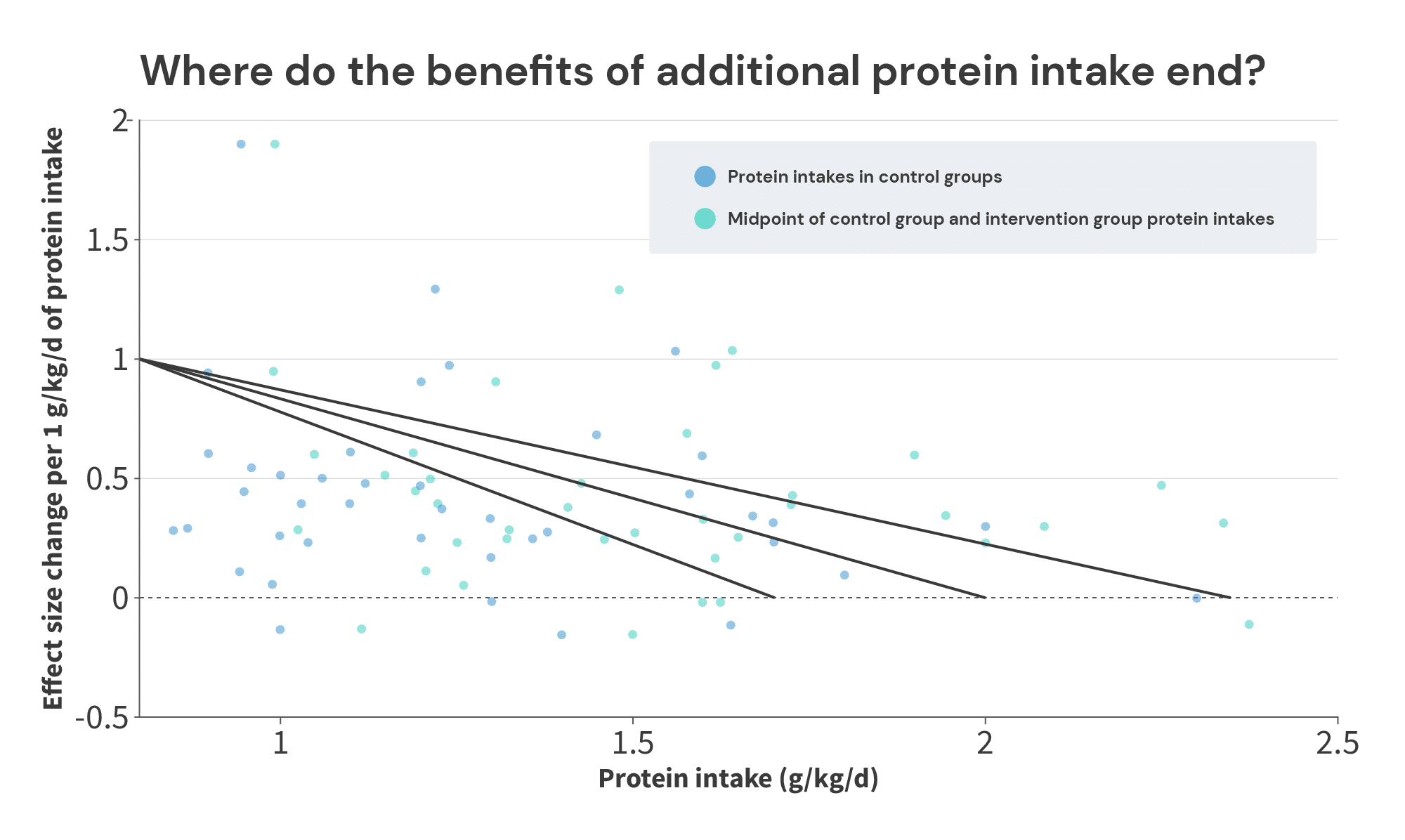

Subsequent, we have to convert these impact dimension slopes to precise positive factors in FFM or LBM. Fortunately, the Nunes meta-analysis (which is the place I extracted the info from) offers us a tough conversion from impact dimension items to positive factors in LBM: “Extra protein ingestion most likely results in a small improve in lean physique mass (SMD = 0.22 … ). The change represents roughly 1.3-1.4 kg lean mass achieve through the intervention in contrast with a mean of ~0.8 kg achieve within the placebo/management group (~0.5-0.7 kg distinction between teams).”
In different phrases, an impact dimension of 0.22 roughly corresponded to a distinction in LBM of roughly 0.6kg. So, we multiply the impact dimension slopes by 0.6/0.22 (or 2.7272…) to transform them to LBM slopes (positive factors in LBM per 1g/kg improve in protein consumption).
Lastly, all we have to do is choose the purpose at which to middle our plot. I made a decision to middle it on a most quantity of LBM accretion of 1.8kg. I made this choice for 2 causes. First, that’s roughly the common quantity of LBM or FFM gained within the teams consuming giant quantities of protein within the longitudinal research. Second, that worth implies that you’d anticipate to achieve roughly no LBM when solely consuming 0.8g/kg, which matches up properly with the opposite meta-regressions on the subject.
So, with out additional ado:
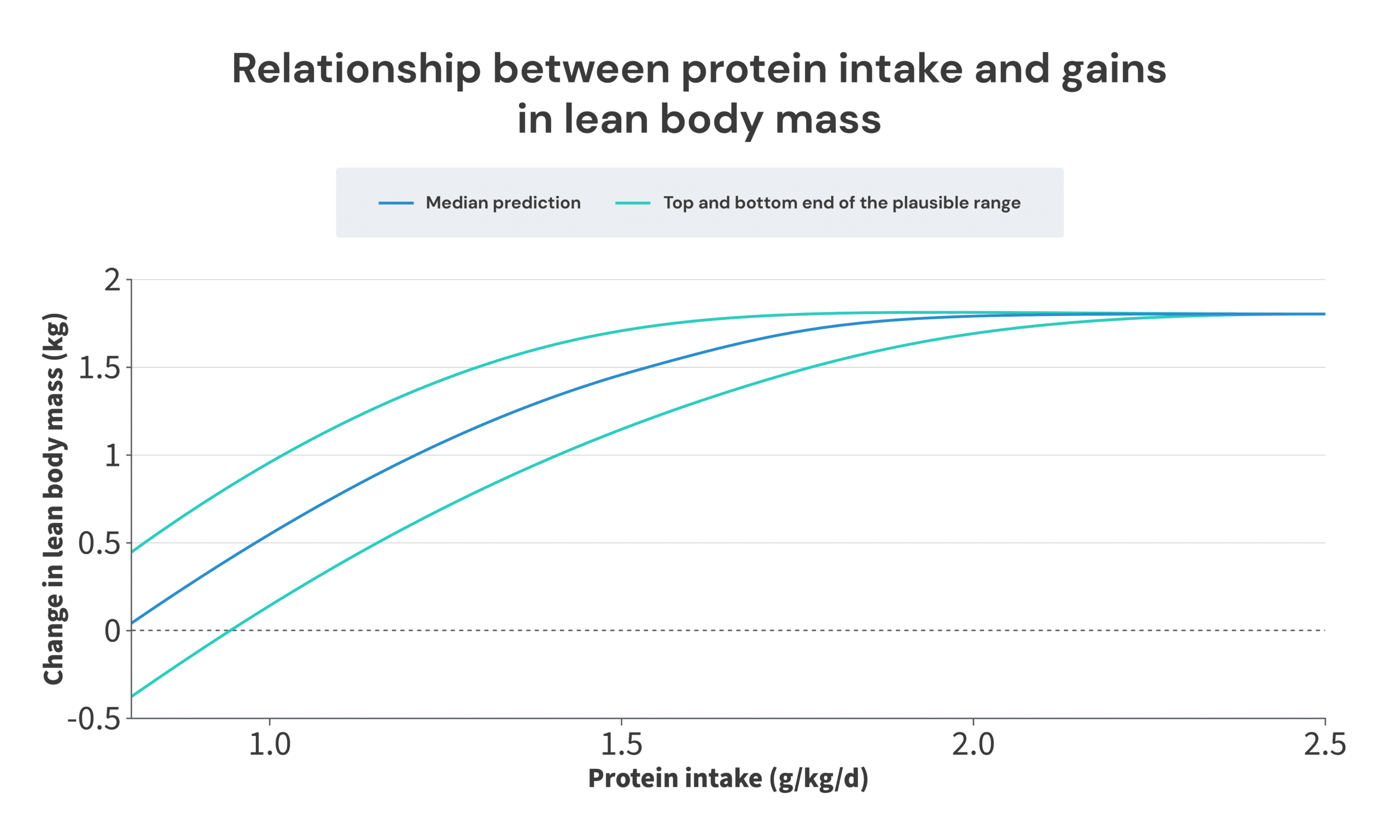

In the end, this paints an image that’s not too dissimilar from the place we began. I do assume a radical and cautious evaluation of this physique of analysis means that there are advantages to consuming extra protein than 1.62g/kg, however this evaluation additionally suggests that you just wouldn’t be leaving too many positive factors on the desk by sticking with 1.62g/kg. The regression line from the Morton meta-analysis neatly splits the median (advantages prime out at 2.0g/kg) and bottom-end predictions (advantages prime out at 1.7g/kg). Moreover, the almost definitely “breakpoint” recognized on this article (2.0g/kg) remains to be throughout the breakpoint confidence interval of the Morton paper (1.03-2.20g/kg). So, I do nonetheless assume the suggestions from the Morton meta-analysis are a bit too conservative, however I additionally don’t assume I might be accused of developing with suggestions which are completely out of left area, and wildly inconsistent with the present consensus.
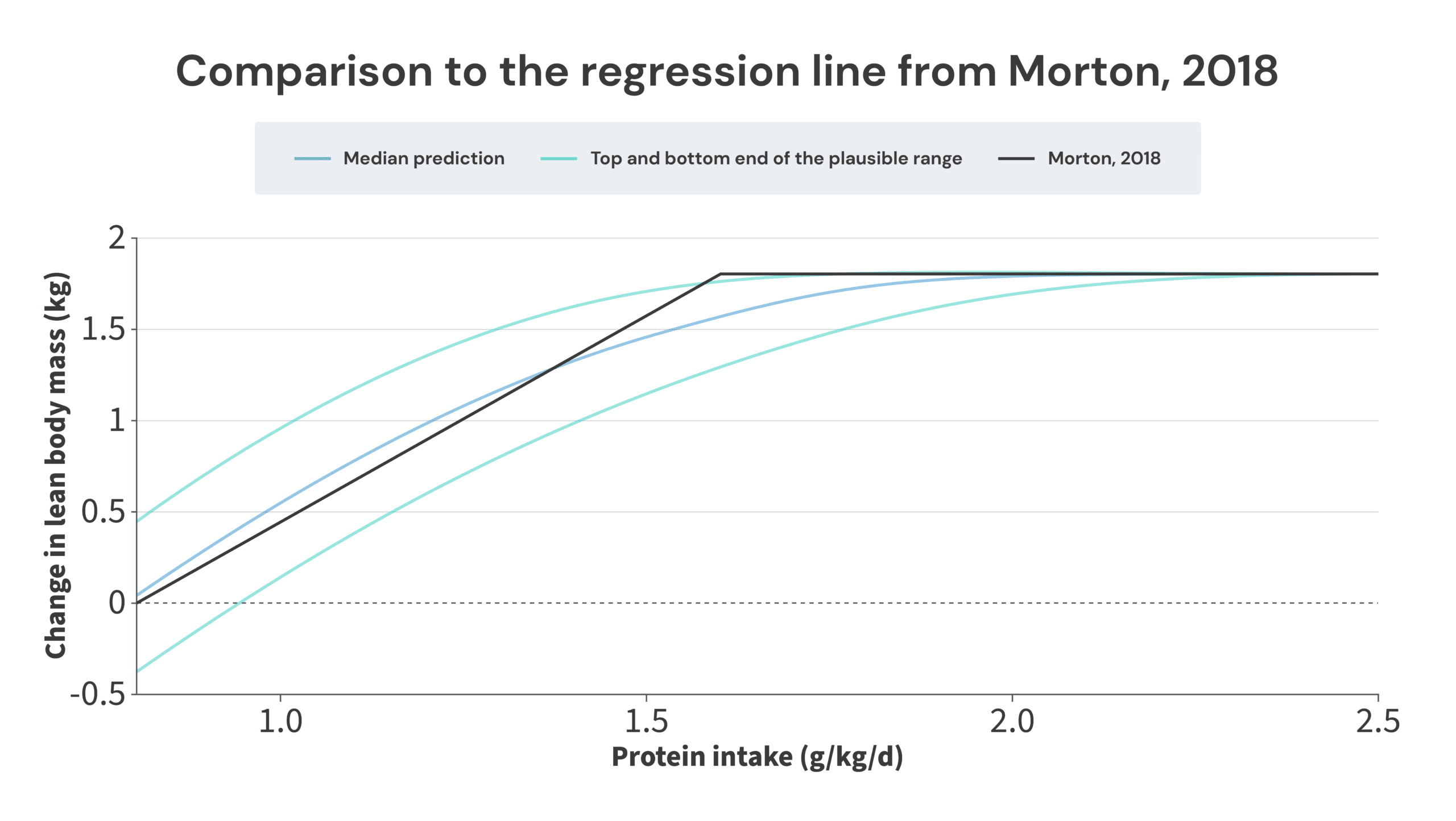

As a basic notice concerning the 1.7-2.35g/kg vary proposed on this article, I’ve way more confidence concerning the backside finish of that vary (the advantages of consuming extra protein prolong as much as a minimum of 1.7g/kg) than the highest finish, merely as a result of information density. In different phrases, now we have quite a lot of examples of topics rising their protein consumption from ~1.6-1.7g/kg to some larger degree of protein consumption, and gaining extra FFM in consequence, so we will be fairly assured that the advantages of consuming extra protein don’t max out under an consumption of 1.7g/kg. Nonetheless, we solely have three research with the midpoint of protein intakes between teams was above 2.35g/kg. In these three research, larger protein intakes didn’t yield additional will increase in FFM, however in the end, we are coping with simply three research. With such a small physique of analysis, it will solely take a few optimistic findings to stretch the higher restrict additional. Moreover, I personally felt snug excluding the Willoughby examine from the evaluation, but when you don’t, you can already make the case that there could also be advantages of protein consumption ranges as much as a minimum of 2.5g/kg. The truth that the evaluation of longitudinal research matches up effectively with the higher finish of values within the IAAO literature does give me a bit extra confidence in 2.35g/kg being the higher finish of the vary, however I’m additionally open to the concept it might find yourself being 0.1-0.2g/kg decrease, or 0.2-0.4g/kg larger, as soon as now we have extra research testing the consequences of actually excessive protein intakes.
Relatedly, topics have a tendency to barely under-report their protein consumption (by about 5%). Protein consumption in longitudinal research is sort of at all times assessed by way of self-report (sometimes by way of meals diaries). This small bias could also be carried by all of those analyses. So, the precise optimum protein consumption vary could also be round 5% larger than a direct studying of the analysis would recommend. Nonetheless, I additionally discover it believable that resistance trainees could not under-report their protein consumption (I wouldn’t even be shocked in the event that they barely over-report their protein consumption). So, for the reason that potential bias is small, and I’m not assured that it will even apply to the precise populations of topics in these research, I selected to not right for it.
I’d additionally identical to to notice that I don’t fault the researchers concerned with the Morton paper for (what I consider to be) the shortcomings of their analyses. Neglecting to account for the potential affect of Simpson’s paradox is an extremely simple oversight to make, and the analyses carried out in that examine had been considerably higher than something that existed within the printed literature as much as that time.
Earlier than I wrap up, I additionally really feel obliged to incorporate this notice: I’m not saying that everybody must devour 2.35g/kg. I believe that (and my evaluation means that) an consumption of round 1.2-1.5g/kg will nonetheless will let you obtain most of your potential positive factors. So, in case you don’t favor actually excessive protein intakes, that’s completely positive. I do assume you’ll most likely be leaving some positive factors on the desk, however I additionally assume you’ll be capable of make some actually strong positive factors.
Takeaways
- A protein consumption of round 2g/kg (0.9g/lb) is required to maximise positive factors for males, on common.
- If you happen to’re a person desirous to take a “higher secure than sorry” method to protein consumption, aiming for two.35g/kg (1.07g/lb) ought to do the trick. That ought to maximize muscle progress within the overwhelming majority of people.
- If we break up the distinction, the outdated “1g/lb” rule really appears to match the analysis fairly effectively.
- Consumption targets for ladies ought to most likely be about 10-15% decrease. Aiming for 1.75g/kg (round 0.8g/lb) ought to maximize muscle progress, on common. If you happen to’re a lady desirous to take a “higher secure than sorry” method to protein consumption, 2.05g/kg (0.93g/lb) ought to do the trick.
- If in case you have a tough concept of your physique composition, it’s most likely finest to scale protein targets to fat-free mass, moderately than complete physique mass. 2.35g/kg of fat-free mass (1.07g/lb of fat-free mass) ought to maximize your positive factors, on common, and a couple of.75g/kg of fat-free mass (1.25g/lb of fat-free mass) serves as an awesome “higher secure than sorry” goal.
- If in case you have a choice for decrease protein intakes, goal for ~1.2-1.5g/kg (0.55-0.7g/lb). This could nonetheless will let you obtain most of your potential positive factors, whereas having significantly extra dietary flexibility.
